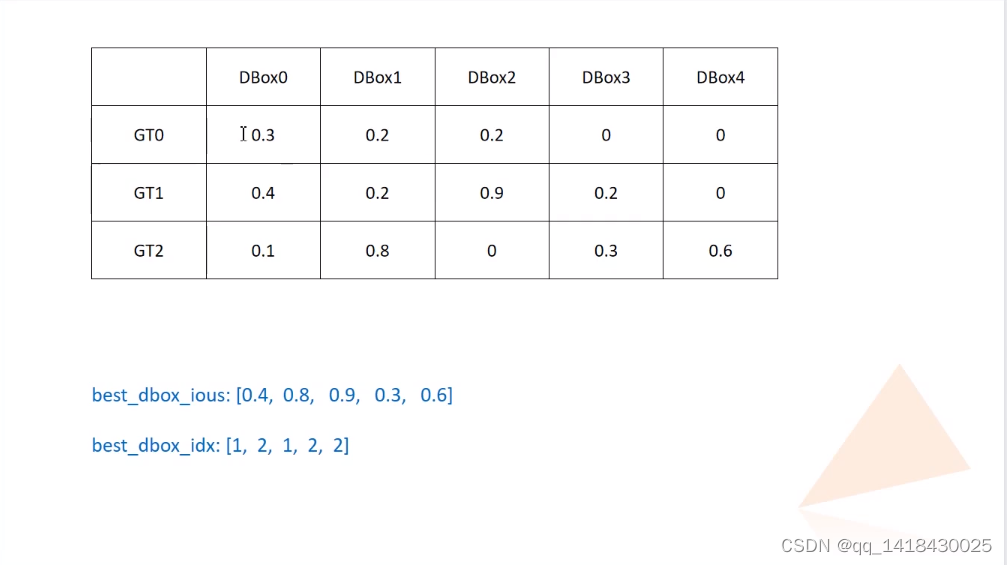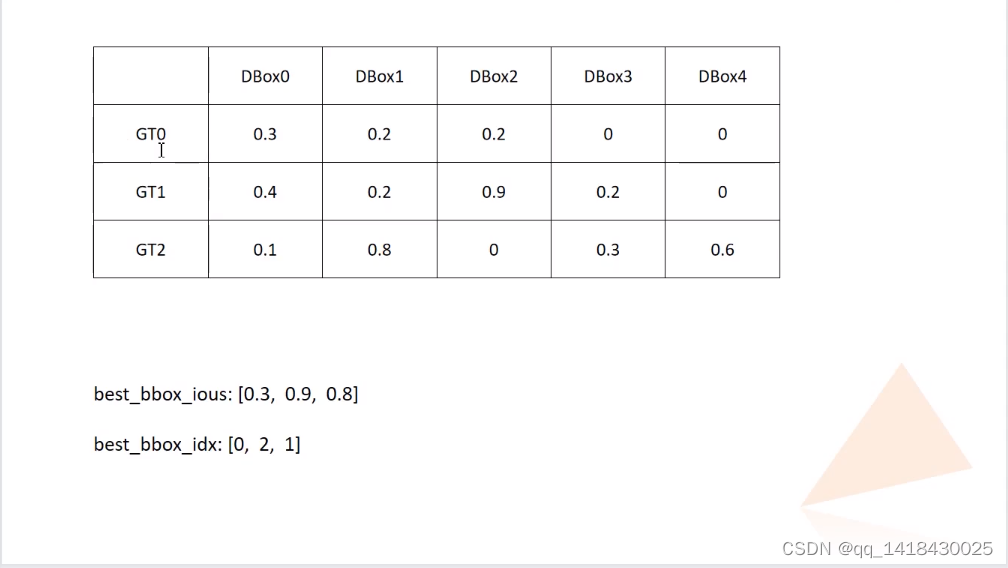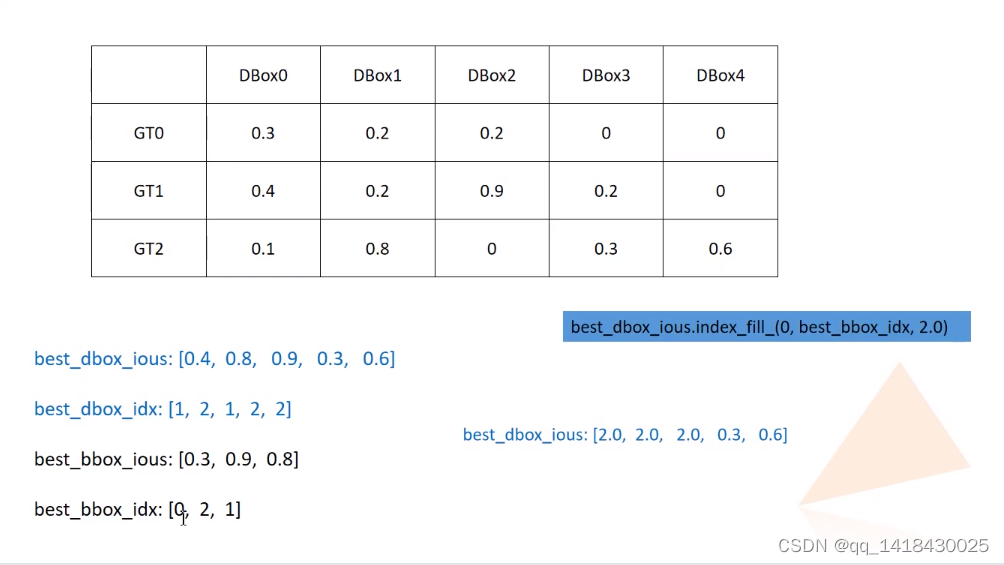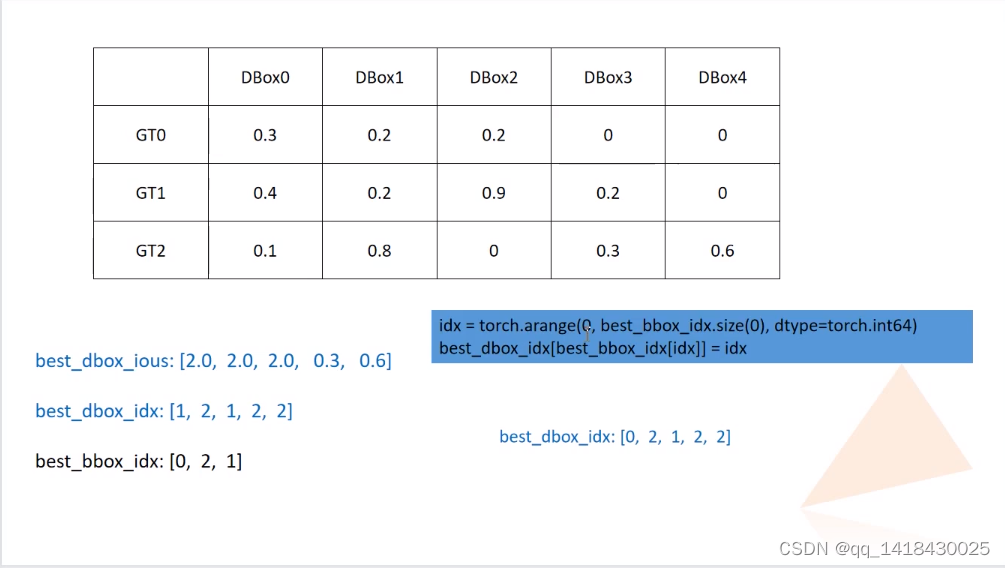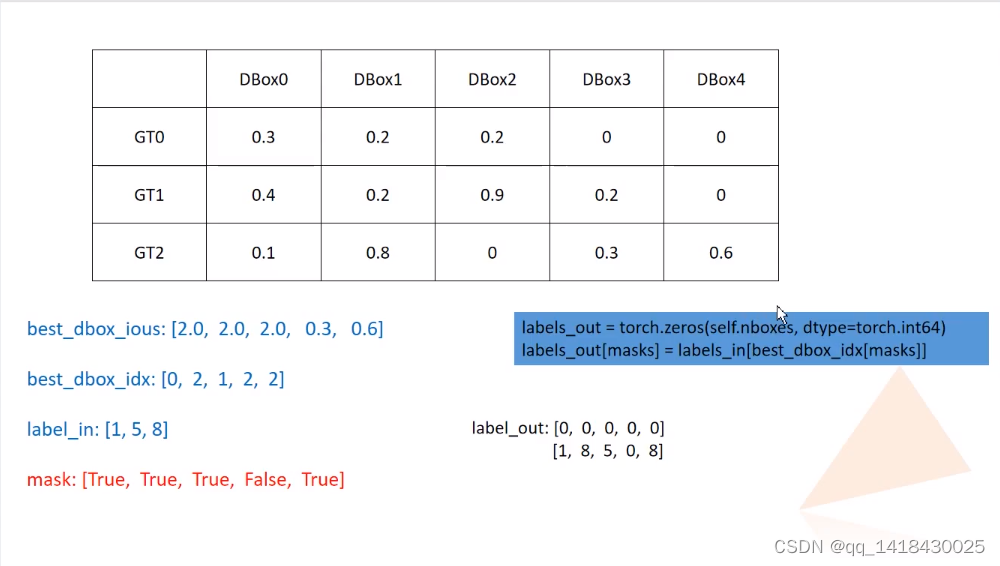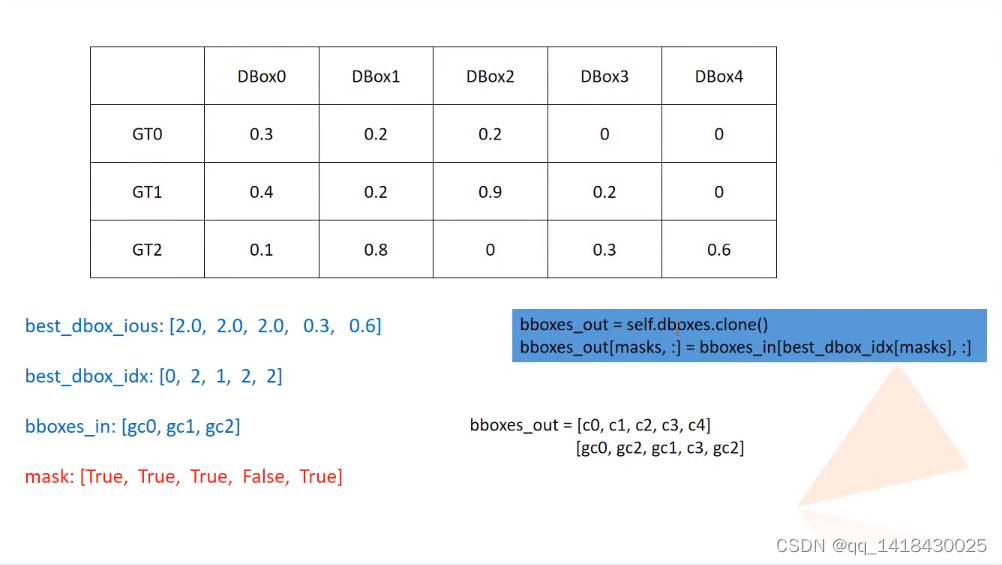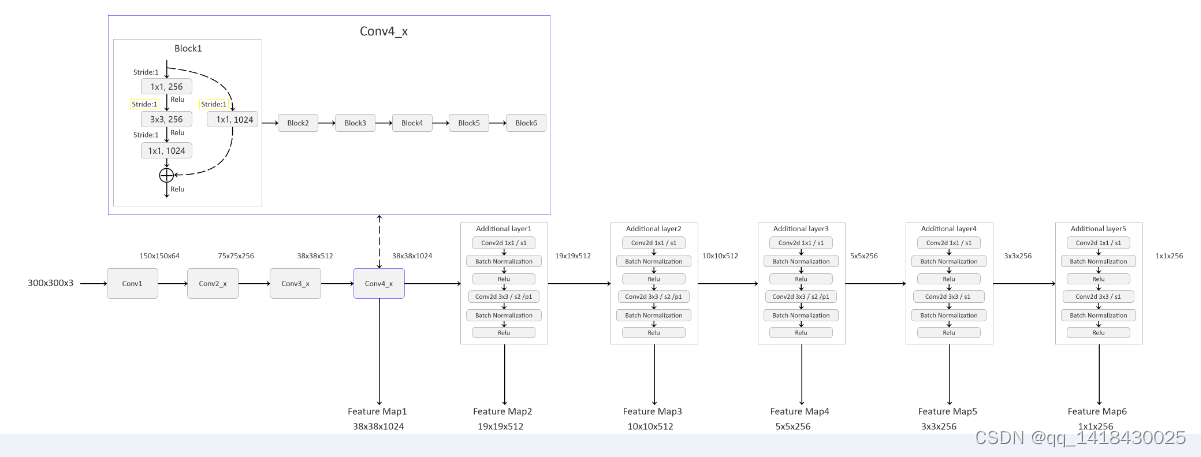前言
随着人工智能的不断发展,机器学习这门技术也越来越重要,很多人都开启了学习机器学习,本文就介绍了机器学习的基础内容。来源于哔哩哔哩博主“霹雳吧啦Wz”,博主学习作为笔记记录,欢迎大家一起讨论学习交流。
一、SSD源码使用介绍
如果用自己数据集,要修改三个部分:一是修改数据集路劲,然后二是再修改NUM-CLSS类别(类别+1,其中1是背景),三是要修改标签.json文件。案例是以Pascol_VOC数据集为例(0代表是背景,从1开始排序)。
二、SSD网络的搭建
2.1 Resnet网络
import torch.nn as nn
import torch
class Bottleneck(nn.Module):
expansion = 4
def __init__(self, in_channel, out_channel, stride=1, downsample=None):
super(Bottleneck, self).__init__()
self.conv1 = nn.Conv2d(in_channels=in_channel, out_channels=out_channel,
kernel_size=1, stride=1, bias=False) # squeeze channels
self.bn1 = nn.BatchNorm2d(out_channel)
# -----------------------------------------
self.conv2 = nn.Conv2d(in_channels=out_channel, out_channels=out_channel,
kernel_size=3, stride=stride, bias=False, padding=1)
self.bn2 = nn.BatchNorm2d(out_channel)
# -----------------------------------------
self.conv3 = nn.Conv2d(in_channels=out_channel, out_channels=out_channel*self.expansion,
kernel_size=1, stride=1, bias=False) # unsqueeze channels
self.bn3 = nn.BatchNorm2d(out_channel*self.expansion)
self.relu = nn.ReLU(inplace=True)
self.downsample = downsample
def forward(self, x):
identity = x
if self.downsample is not None:
identity = self.downsample(x)
out = self.conv1(x)
out = self.bn1(out)
out = self.relu(out)
out = self.conv2(out)
out = self.bn2(out)
out = self.relu(out)
out = self.conv3(out)
out = self.bn3(out)
out += identity
out = self.relu(out)
return out
class ResNet(nn.Module):
def __init__(self, block, blocks_num, num_classes=1000, include_top=True):
super(ResNet, self).__init__()
self.include_top = include_top
self.in_channel = 64
self.conv1 = nn.Conv2d(3, self.in_channel, kernel_size=7, stride=2,
padding=3, bias=False)
self.bn1 = nn.BatchNorm2d(self.in_channel)
self.relu = nn.ReLU(inplace=True)
self.maxpool = nn.MaxPool2d(kernel_size=3, stride=2, padding=1)
self.layer1 = self._make_layer(block, 64, blocks_num[0])
self.layer2 = self._make_layer(block, 128, blocks_num[1], stride=2)
self.layer3 = self._make_layer(block, 256, blocks_num[2], stride=2)
self.layer4 = self._make_layer(block, 512, blocks_num[3], stride=2)
if self.include_top:
self.avgpool = nn.AdaptiveAvgPool2d((1, 1)) # output size = (1, 1)
self.fc = nn.Linear(512 * block.expansion, num_classes)
for m in self.modules():
if isinstance(m, nn.Conv2d):
nn.init.kaiming_normal_(m.weight, mode='fan_out', nonlinearity='relu')
def _make_layer(self, block, channel, block_num, stride=1):
downsample = None
if stride != 1 or self.in_channel != channel * block.expansion:
downsample = nn.Sequential(
nn.Conv2d(self.in_channel, channel * block.expansion, kernel_size=1, stride=stride, bias=False),
nn.BatchNorm2d(channel * block.expansion))
layers = []
layers.append(block(self.in_channel, channel, downsample=downsample, stride=stride))
self.in_channel = channel * block.expansion
for _ in range(1, block_num):
layers.append(block(self.in_channel, channel))
return nn.Sequential(*layers)
def forward(self, x):
x = self.conv1(x)
x = self.bn1(x)
x = self.relu(x)
x = self.maxpool(x)
x = self.layer1(x)
x = self.layer2(x)
x = self.layer3(x)
x = self.layer4(x)
if self.include_top:
x = self.avgpool(x)
x = torch.flatten(x, 1)
x = self.fc(x)
return x
def resnet50(num_classes=1000, include_top=True):
return ResNet(Bottleneck, [3, 4, 6, 3], num_classes=num_classes, include_top=include_top)
2.2 骨干网络(根据网路结构图来看 骨干采用的Resnet)
class Backbone(nn.Module):
def __init__(self, pretrain_path=None):
super(Backbone, self).__init__()
net = resnet50()
self.out_channels = [1024, 512, 512, 256, 256, 256]#每一个预测层channel
if pretrain_path is not None:#预训练权重
net.load_state_dict(torch.load(pretrain_path))
self.feature_extractor = nn.Sequential(*list(net.children())[:7])#构建特征提取部分 从conv1-conv4 子模块:nn.结构 左闭右开,索引0-6位置
conv4_block1 = self.feature_extractor[-1][0] #得到conv4的第一个模块
# 修改conv4_block1的步距,从2->1
conv4_block1.conv1.stride = (1, 1)
conv4_block1.conv2.stride = (1, 1)
conv4_block1.downsample[0].stride = (1, 1)
def forward(self, x):
x = self.feature_extractor(x)
return x
2.3 额外的一系列卷积层+预测器+初始化(对额外卷积层和预测器)
class SSD300(nn.Module):
def __init__(self, backbone=None, num_classes=21):
super(SSD300, self).__init__()
if backbone is None:
raise Exception("backbone is None")
if not hasattr(backbone, "out_channels"):
raise Exception("the backbone not has attribute: out_channel")
self.feature_extractor = backbone
self.num_classes = num_classes
# out_channels = [1024, 512, 512, 256, 256, 256] for resnet50
self._build_additional_features(self.feature_extractor.out_channels)#添加额外的一系列卷积层,得到相应的一系列特征提取器
self.num_defaults = [4, 6, 6, 6, 4, 4]#每一个预测特征层的每一个cell的框的个数 先验框anchor/bounding box/default box
location_extractors = []#预测器定位
confidence_extractors = []#预测器置信度
# out_channels = [1024, 512, 512, 256, 256, 256] for resnet50
for nd, oc in zip(self.num_defaults, self.feature_extractor.out_channels):
# nd is number_default_boxes, oc is output_channel
location_extractors.append(nn.Conv2d(oc, nd * 4, kernel_size=3, padding=1))
confidence_extractors.append(nn.Conv2d(oc, nd * self.num_classes, kernel_size=3, padding=1))
self.loc = nn.ModuleList(location_extractors)
self.conf = nn.ModuleList(confidence_extractors)
self._init_weights()
default_box = dboxes300_coco()
self.compute_loss = Loss(default_box)#损失
self.encoder = Encoder(default_box)
self.postprocess = PostProcess(default_box)#后处理
def _init_weights(self):
layers = [*self.additional_blocks, *self.loc, *self.conf]
for layer in layers:
for param in layer.parameters():
if param.dim() > 1:
nn.init.xavier_uniform_(param)
2.4 添加额外的一系列卷积层,得到相应的一系列特征提取器
def _build_additional_features(self, input_size):
"""
为backbone(resnet50)添加额外的一系列卷积层,得到相应的一系列特征提取器
:param input_size:
:return:
"""
additional_blocks = []
# input_size = [1024, 512, 512, 256, 256, 256] for resnet50
middle_channels = [256, 256, 128, 128, 128]#输出层的第一个卷积的深度
for i, (input_ch, output_ch, middle_ch) in enumerate(zip(input_size[:-1], input_size[1:], middle_channels)):
padding, stride = (1, 2) if i < 3 else (0, 1)#判断是否为前三个特征提取器
layer = nn.Sequential(
nn.Conv2d(input_ch, middle_ch, kernel_size=1, bias=False),
nn.BatchNorm2d(middle_ch),
nn.ReLU(inplace=True),
nn.Conv2d(middle_ch, output_ch, kernel_size=3, padding=padding, stride=stride, bias=False),
nn.BatchNorm2d(output_ch),
nn.ReLU(inplace=True),
)
additional_blocks.append(layer)
self.additional_blocks = nn.ModuleList(additional_blocks)
2.5 正向传播过程(根据图来理解代码 要多看网络结构图)
def forward(self, image, targets=None):
x = self.feature_extractor(image)#conv4 38x38x1024
# Feature Map 38x38x1024, 19x19x512, 10x10x512, 5x5x256, 3x3x256, 1x1x256
detection_features = torch.jit.annotate(List[Tensor], []) # [x]存储每一个特征层的列表
detection_features.append(x)
for layer in self.additional_blocks:#遍历每一个预测特征层
x = layer(x)#将上一层输出送到当前层 得到当前层对应的输出
detection_features.append(x)#再将当前层输出添加到列表当中
# Feature Map 38x38x4, 19x19x6, 10x10x6, 5x5x6, 3x3x4, 1x1x4
locs, confs = self.bbox_view(detection_features, self.loc, self.conf)#两个回归参数
# For SSD 300, shall return nbatch x 8732 x {
nlabels, nlocs} results
# 38x38x4 + 19x19x6 + 10x10x6 + 5x5x6 + 3x3x4 + 1x1x4 = 8732
if self.training:#训练模式下 计算损失
if targets is None:
raise ValueError("In training mode, targets should be passed")
# bboxes_out (Tensor 8732 x 4), labels_out (Tensor 8732)
bboxes_out = targets['boxes']
bboxes_out = bboxes_out.transpose(1, 2).contiguous()
# print(bboxes_out.is_contiguous())
labels_out = targets['labels']
# print(labels_out.is_contiguous())
# ploc, plabel, gloc, glabel
loss = self.compute_loss(locs, confs, bboxes_out, labels_out)
return {
"total_losses": loss}
# 将预测回归参数叠加到default box上得到最终预测box,并执行非极大值抑制虑除重叠框
# results = self.encoder.decode_batch(locs, confs)
results = self.postprocess(locs, confs)#非训练模式下 后处理得到输出
return results
2.6 两个回归参数
# Shape the classifier to the view of bboxes
def bbox_view(self, features, loc_extractor, conf_extractor):
locs = []
confs = []
for f, l, c in zip(features, loc_extractor, conf_extractor):#每一个预测特征层 特征图feature_map的位置参数(预测器) 特征图feature_map的置信度参数(预测器)
# [batch, n*4, feat_size(h), feat_size(w)] -> [batch, 4, -1]
locs.append(l(f).view(f.size(0), 4, -1))#-1代表自动推理最后一个位置元素的个数 其实是n x feat_size x feat_size 即当前预测特征层的所有default box数目
# [batch, n*classes, feat_size(h), feat_size(w)] -> [batch, classes, -1]
confs.append(c(f).view(f.size(0), self.num_classes, -1))#-1代表自动推理最后一个位置元素的个数 其实是n x feat_size x feat_size 即当前预测特征层的所有default box数目
locs, confs = torch.cat(locs, 2).contiguous(), torch.cat(confs, 2).contiguous()#拼接最后一个维度 即上面的-1维度
return locs, confs
三、Default Box生成
3.1 在utils.py文件中Default Boxes模块实现方法:(SSD有6个预测特征层,每一个预测特征层会有两个scale(尺度)。关于比例:第一个预测特征层、最后两个预测特征层1:1;2:1;1:2。剩下的三个预测特征层除了1:1;2:1;1:2之外,还有3:1和1:3)(每一层预测特征层的两个scale,第一个scale会有1:1;2:1;1:2这三个default box。还有一个scale=根号第一个scaleX第二个scale,比例只有1:1)
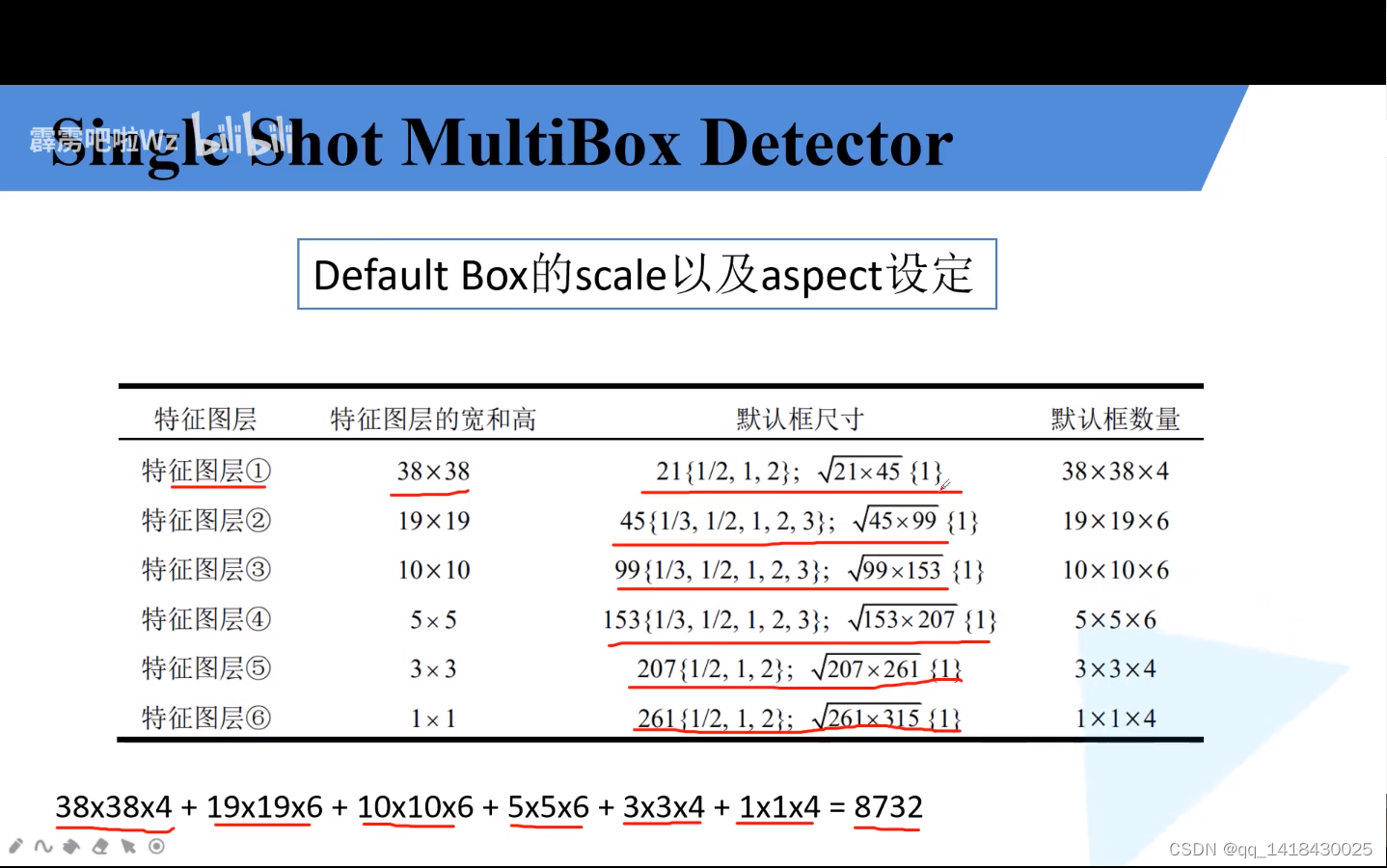
class DefaultBoxes(object):
def __init__(self, fig_size, feat_size, steps, scales, aspect_ratios, scale_xy=0.1, scale_wh=0.2):
self.fig_size = fig_size # 输入网络的图像大小 300
# [38, 19, 10, 5, 3, 1]
self.feat_size = feat_size # 每个预测层的feature map尺寸(根据网络结构图看)
self.scale_xy_ = scale_xy#损失的一个参数
self.scale_wh_ = scale_wh
# According to https://github.com/weiliu89/caffe
# Calculation method slightly different from paper
# [8, 16, 32, 64, 100, 300]
self.steps = steps # 每个特征层上的一个cell在原图上的跨度(理论上是等于fig_size/feat_size)
# [21, 45, 99, 153, 207, 261, 315]
self.scales = scales # 每个特征层上预测的default box的scale
fk = fig_size / np.array(steps) # 计算每层特征层的fk(原论文说是feat_size,即每个预测层的尺寸)
# [[2], [2, 3], [2, 3], [2, 3], [2], [2]]
self.aspect_ratios = aspect_ratios # 每个预测特征层上预测的default box的ratios
self.default_boxes = []
# size of feature and number of feature
# 遍历每层特征层,计算default box
for idx, sfeat in enumerate(self.feat_size):
sk1 = scales[idx] / fig_size # scale转为相对值[0-1]
sk2 = scales[idx + 1] / fig_size # scale转为相对值[0-1]
sk3 = sqrt(sk1 * sk2)
# 先添加两个1:1比例的default box宽和高
all_sizes = [(sk1, sk1), (sk3, sk3)]
# 再将剩下不同比例的default box宽和高添加到all_sizes中
for alpha in aspect_ratios[idx]:
w, h = sk1 * sqrt(alpha), sk1 / sqrt(alpha)
all_sizes.append((w, h))#2:1
all_sizes.append((h, w))#1:2
# 计算当前特征层对应原图上的所有default box
for w, h in all_sizes:
for i, j in itertools.product(range(sfeat), repeat=2): # i -> 行(y), j -> 列(x) 遍历所有cell
# 计算每个default box的中心坐标(范围是在0-1之间)
cx, cy = (j + 0.5) / fk[idx], (i + 0.5) / fk[idx]#转为相对值[0-1]
self.default_boxes.append((cx, cy, w, h))#坐标信息
# 将default_boxes转为tensor格式
self.dboxes = torch.as_tensor(self.default_boxes, dtype=torch.float32) # 这里不转类型会报错
self.dboxes.clamp_(min=0, max=1) # 裁剪,将坐标(x, y, w, h)都限制在0-1之间
# For IoU calculation
# ltrb is left top coordinate and right bottom coordinate
# 将(x, y, w, h)转换成(xmin, ymin, xmax, ymax),方便后续计算IoU(匹配正负样本时)
self.dboxes_ltrb = self.dboxes.clone()
self.dboxes_ltrb[:, 0] = self.dboxes[:, 0] - 0.5 * self.dboxes[:, 2] # xmin
self.dboxes_ltrb[:, 1] = self.dboxes[:, 1] - 0.5 * self.dboxes[:, 3] # ymin
self.dboxes_ltrb[:, 2] = self.dboxes[:, 0] + 0.5 * self.dboxes[:, 2] # xmax
self.dboxes_ltrb[:, 3] = self.dboxes[:, 1] + 0.5 * self.dboxes[:, 3] # ymax
@property
def scale_xy(self):
return self.scale_xy_
@property
def scale_wh(self):
return self.scale_wh_
def __call__(self, order='ltrb'):
# 根据需求返回对应格式的default box
if order == 'ltrb':
return self.dboxes_ltrb
if order == 'xywh':
return self.dboxes
def dboxes300_coco():
figsize = 300 # 输入网络的图像大小
feat_size = [38, 19, 10, 5, 3, 1] # 每个预测层的feature map尺寸
steps = [8, 16, 32, 64, 100, 300] # 每个特征层上的一个cell在原图上的跨度
# use the scales here: https://github.com/amdegroot/ssd.pytorch/blob/master/data/config.py
scales = [21, 45, 99, 153, 207, 261, 315] # 每个特征层上预测的default box的scale
aspect_ratios = [[2], [2, 3], [2, 3], [2, 3], [2], [2]] # 每个预测特征层上预测的default box的ratios
dboxes = DefaultBoxes(figsize, feat_size, steps, scales, aspect_ratios)
return dboxes
3.2 关于坐标(最后有两种类型坐标,分别是(x, y, w, h)和(xmin, ymin, xmax, ymax))

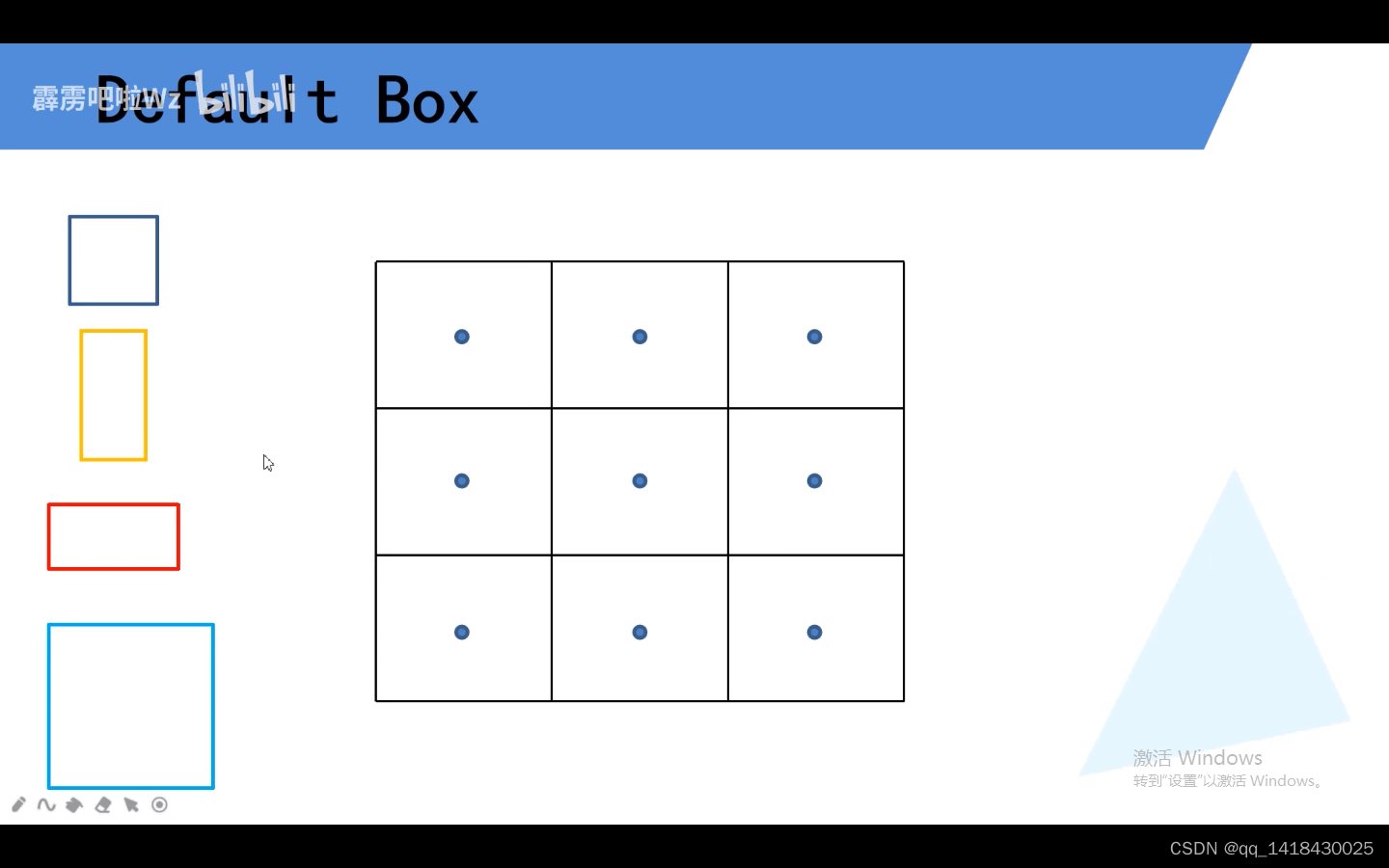
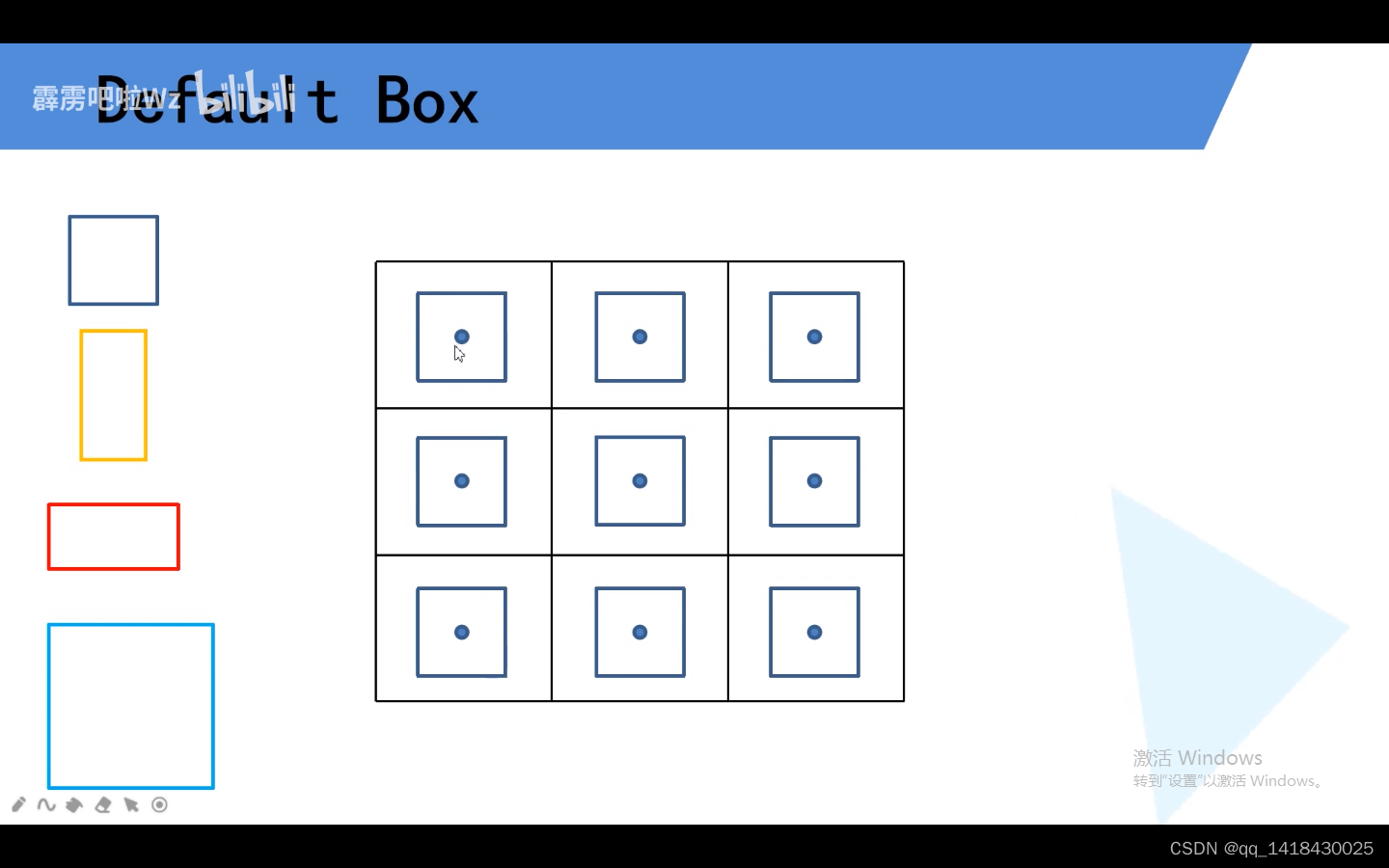
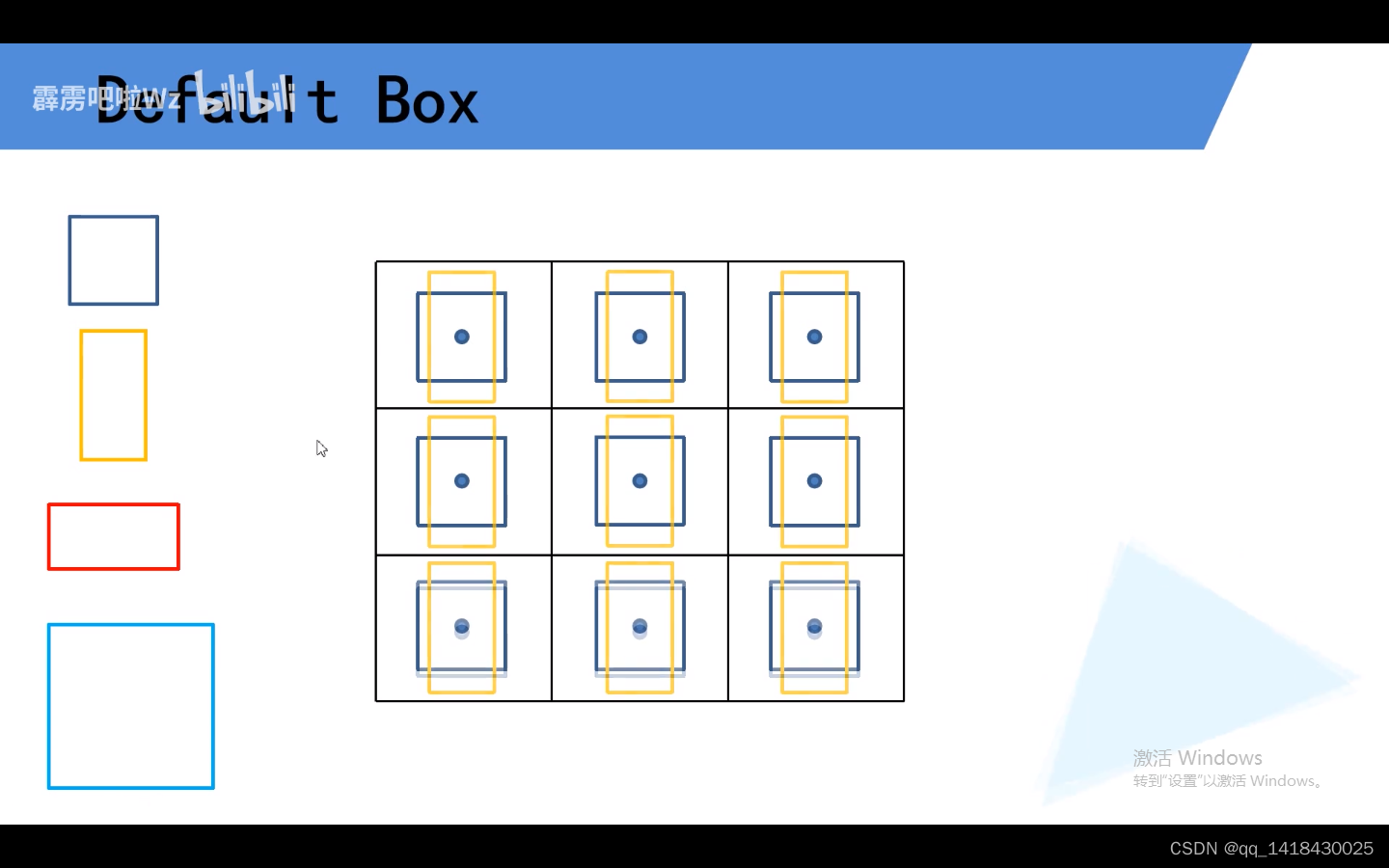
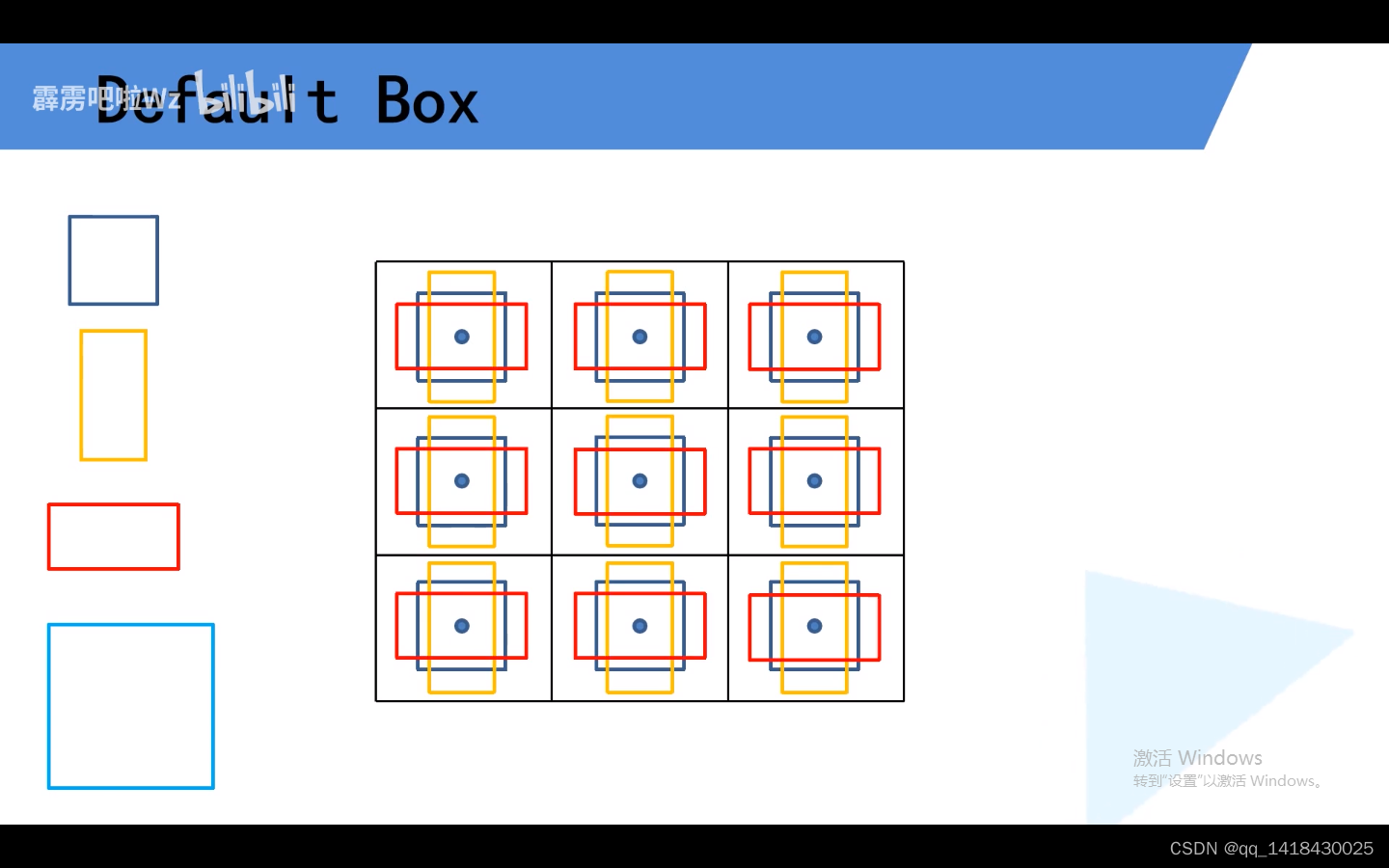
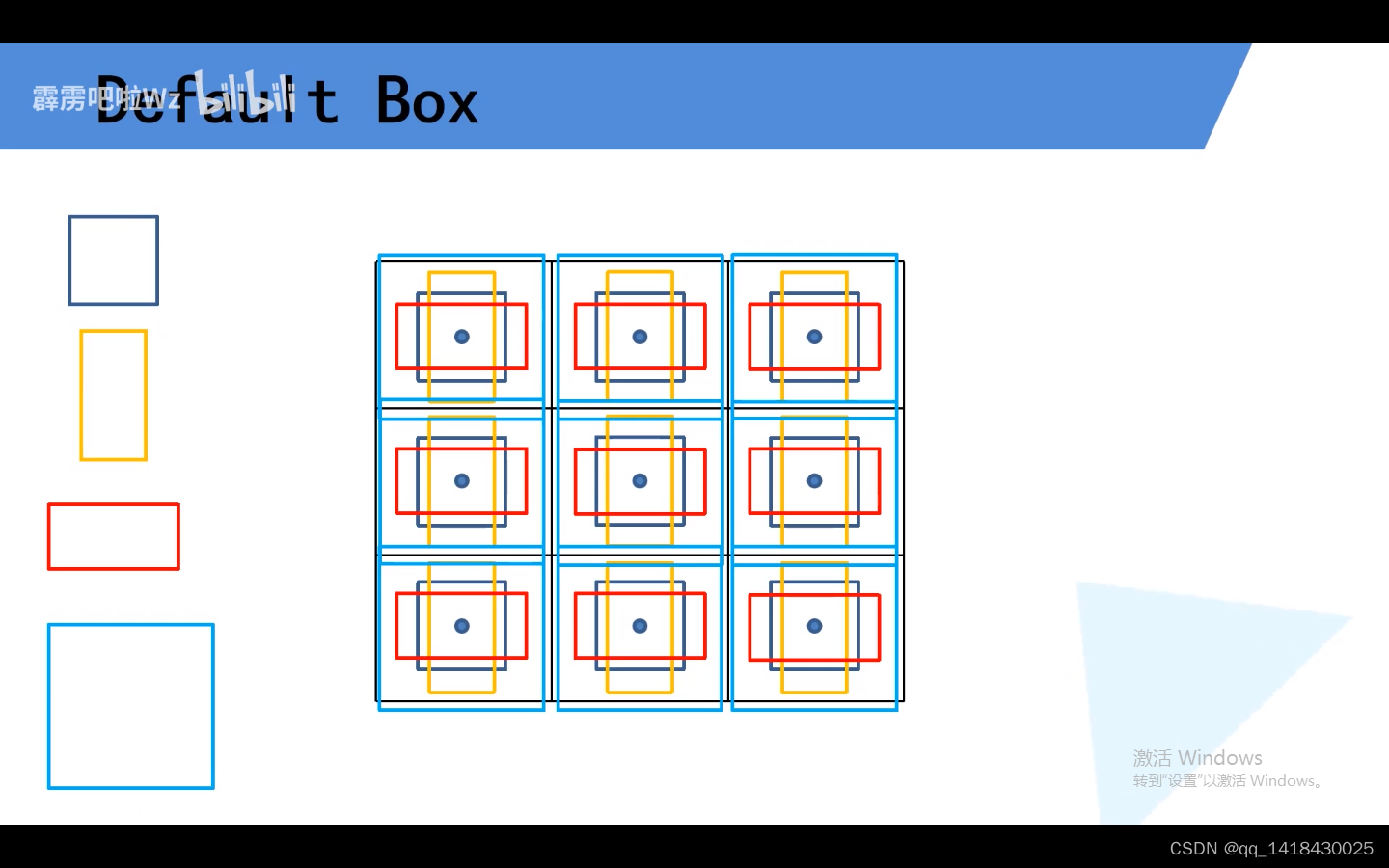
3.3 关于不懂的代码也可以点击单步调试 看看变量的变化


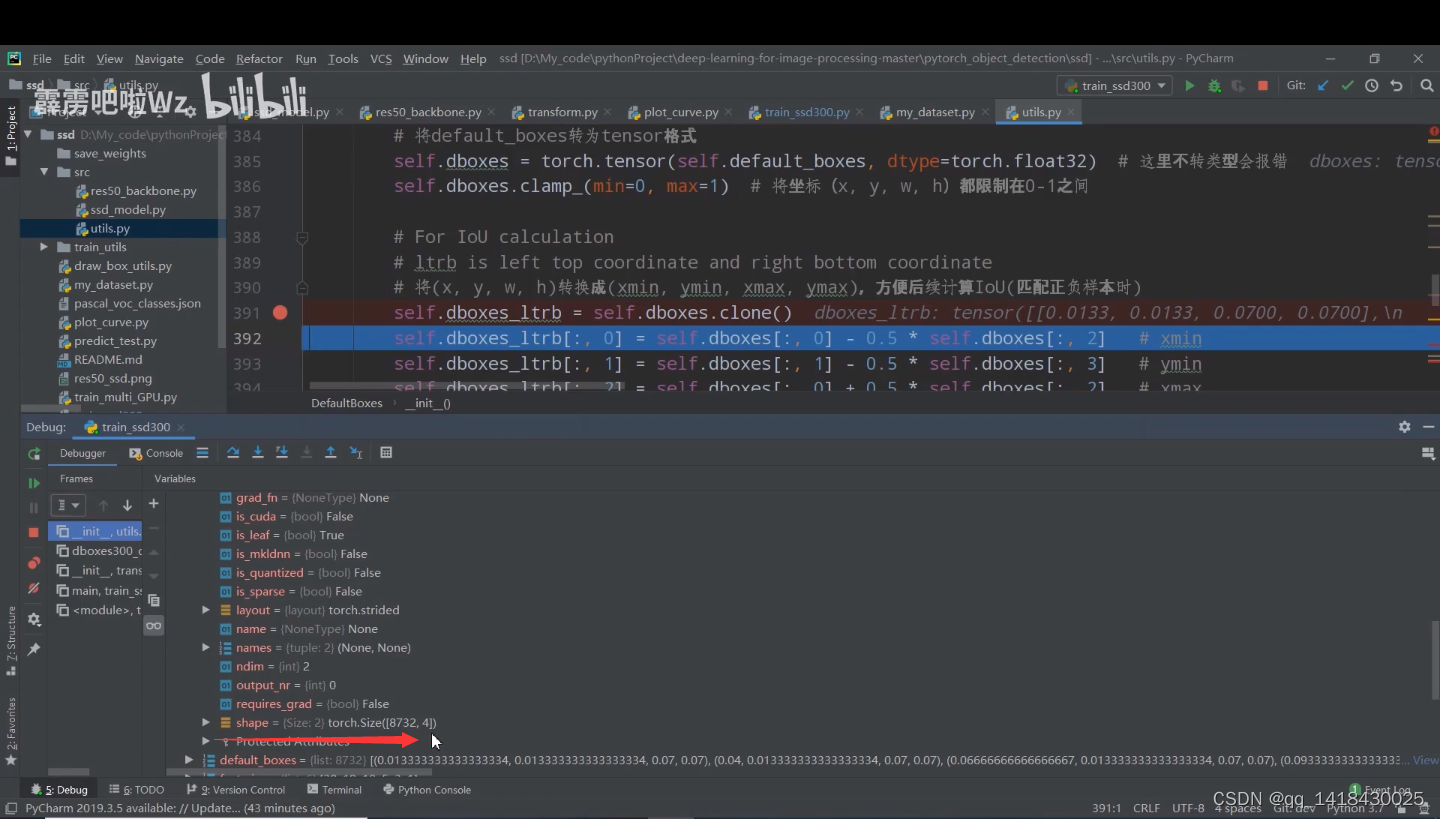
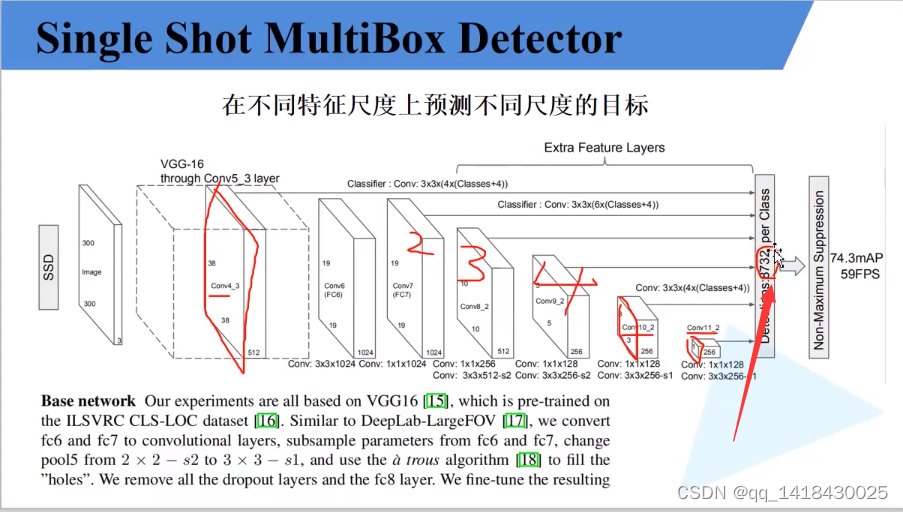
四、Loss的计算
class Loss(nn.Module):
"""
Implements the loss as the sum of the followings:
1. Confidence Loss: All labels, with hard negative mining
2. Localization Loss: Only on positive labels
Suppose input dboxes has the shape 8732x4
"""
def __init__(self, dboxes):
super(Loss, self).__init__()
# Two factor are from following links
# http://jany.st/post/2017-11-05-single-shot-detector-ssd-from-scratch-in-tensorflow.html
self.scale_xy = 1.0 / dboxes.scale_xy # 10
self.scale_wh = 1.0 / dboxes.scale_wh # 5
self.location_loss = nn.SmoothL1Loss(reduction='none')
# [num_anchors, 4] -> [4, num_anchors] -> [1, 4, num_anchors]
self.dboxes = nn.Parameter(dboxes(order="xywh").transpose(0, 1).unsqueeze(dim=0),#交换01位置 再在第一个位置0增加一个新的位置
requires_grad=False)
self.confidence_loss = nn.CrossEntropyLoss(reduction='none')
def _location_vec(self, loc):
# type: (Tensor) -> Tensor
"""
Generate Location Vectors
计算ground truth相对anchors的回归参数
:param loc: anchor匹配到的对应GTBOX Nx4x8732
:return:
"""
gxy = self.scale_xy * (loc[:, :2, :] - self.dboxes[:, :2, :]) / self.dboxes[:, 2:, :] # Nx2x8732(系数加速网络收敛)
gwh = self.scale_wh * (loc[:, 2:, :] / self.dboxes[:, 2:, :]).log() # Nx2x8732(系数加速网络收敛)
return torch.cat((gxy, gwh), dim=1).contiguous()
def forward(self, ploc, plabel, gloc, glabel):
# type: (Tensor, Tensor, Tensor, Tensor) -> Tensor
"""
ploc, plabel: Nx4x8732, Nxlabel_numx8732
predicted location and labels
gloc, glabel: Nx4x8732, Nx8732
ground truth location and labels
"""
# 获取正样本的mask Tensor: [N, 8732] 预处理过程中ancor box对应的gt box对应匹配的GT坐标以及真实标签
mask = torch.gt(glabel, 0) # (gt: >) gt>0 类别索引是从1开始
# mask1 = torch.nonzero(glabel)
# 计算一个batch中的每张图片的正样本个数 Tensor: [N]
pos_num = mask.sum(dim=1) #pos_num:tensor([8,17,18,15,10,11,10,13])
# 计算gt的location回归参数 Tensor: [N, 4, 8732]
vec_gd = self._location_vec(gloc)
# sum on four coordinates, and mask
# 计算定位损失(只有正样本)
loc_loss = self.location_loss(ploc, vec_gd).sum(dim=1) # Tensor: [N, 8732]
loc_loss = (mask.float() * loc_loss).sum(dim=1) # Tenosr: [N]
# hard negative mining Tenosr: [N, 8732]
con = self.confidence_loss(plabel, glabel)
# positive mask will never selected
# 获取负样本
con_neg = con.clone()
con_neg[mask] = 0.0 #将正样本置为0
# 按照confidence_loss降序排列 con_idx(Tensor: [N, 8732])
_, con_idx = con_neg.sort(dim=1, descending=True)
_, con_rank = con_idx.sort(dim=1) # 这个步骤比较巧妙
# number of negative three times positive
# 用于损失计算的负样本数是正样本的3倍(在原论文Hard negative mining部分),
# 但不能超过总样本数8732
neg_num = torch.clamp(3 * pos_num, max=mask.size(1)).unsqueeze(-1)
neg_mask = torch.lt(con_rank, neg_num) # (lt: <) Tensor [N, 8732]
# confidence最终loss使用选取的正样本loss+选取的负样本loss
con_loss = (con * (mask.float() + neg_mask.float())).sum(dim=1) # Tensor [N]
# avoid no object detected
# 避免出现图像中没有GTBOX的情况
total_loss = loc_loss + con_loss
# eg. [15, 3, 5, 0] -> [1.0, 1.0, 1.0, 0.0]
num_mask = torch.gt(pos_num, 0).float() # 统计一个batch中的每张图像中是否存在正样本
pos_num = pos_num.float().clamp(min=1e-6) # 防止出现分母为零的情况
ret = (total_loss * num_mask / pos_num).mean(dim=0) # 只计算存在正样本的图像损失
return ret
4.1 mask(glabel)调试

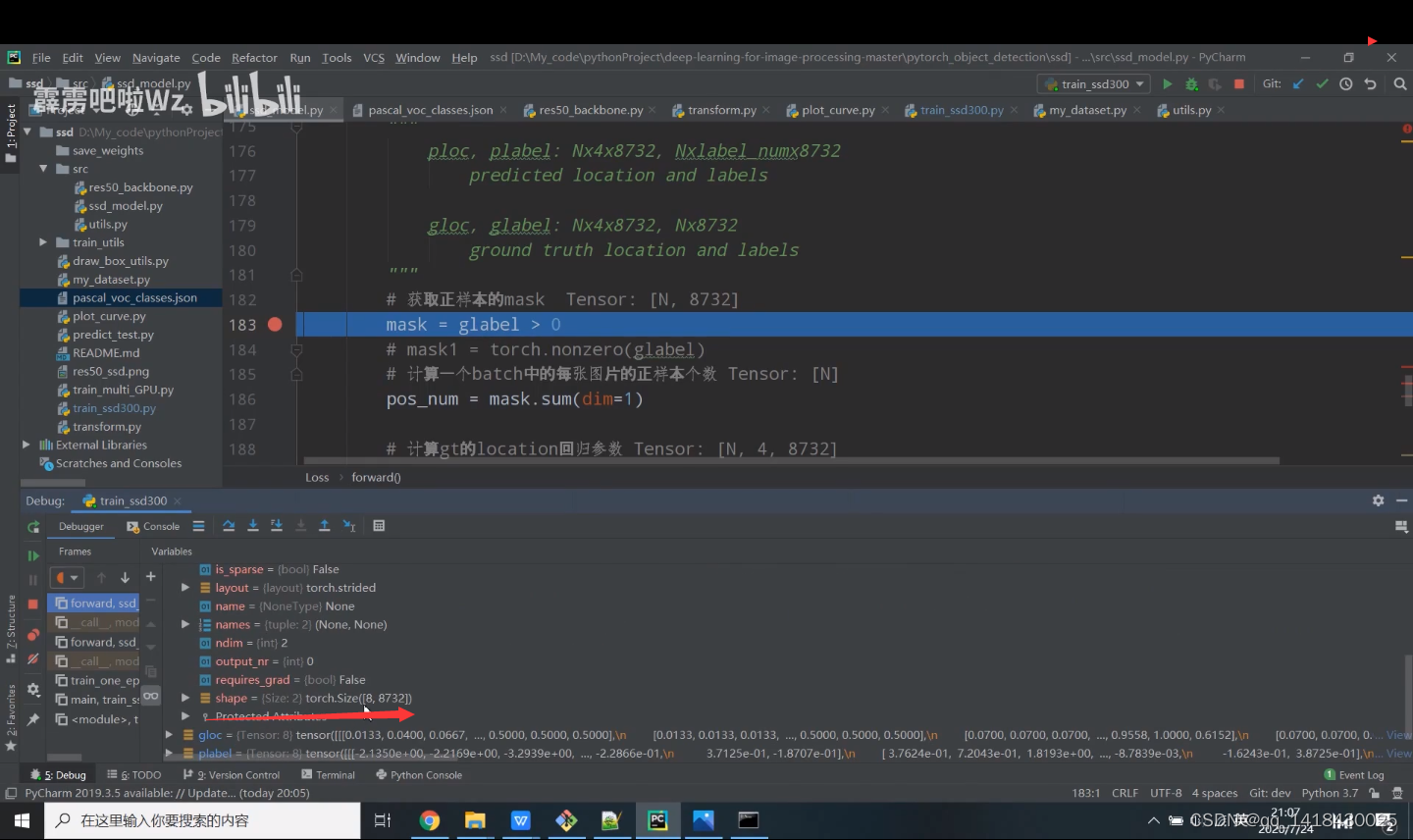

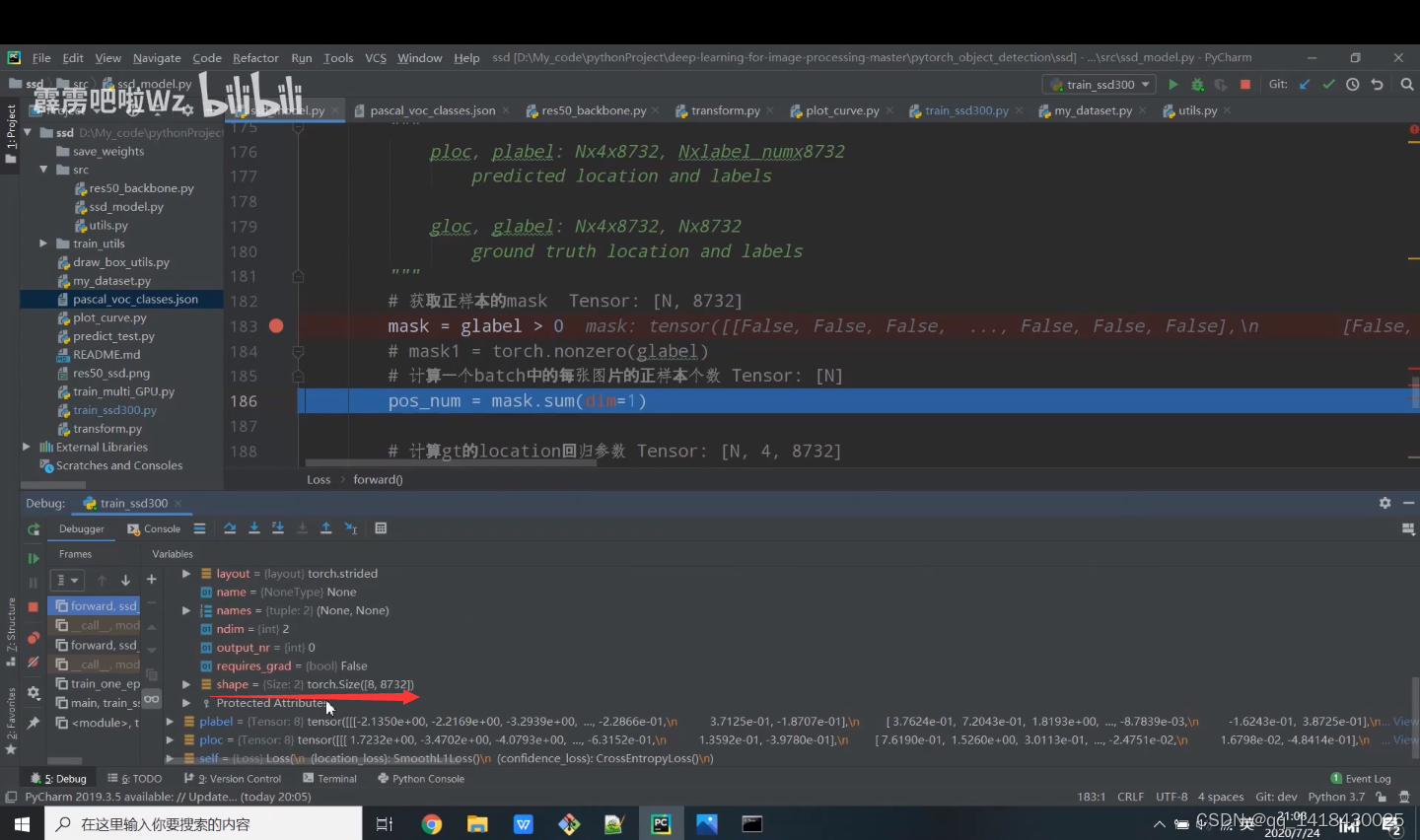
mask和glabel都是相同的维度,8x8732.
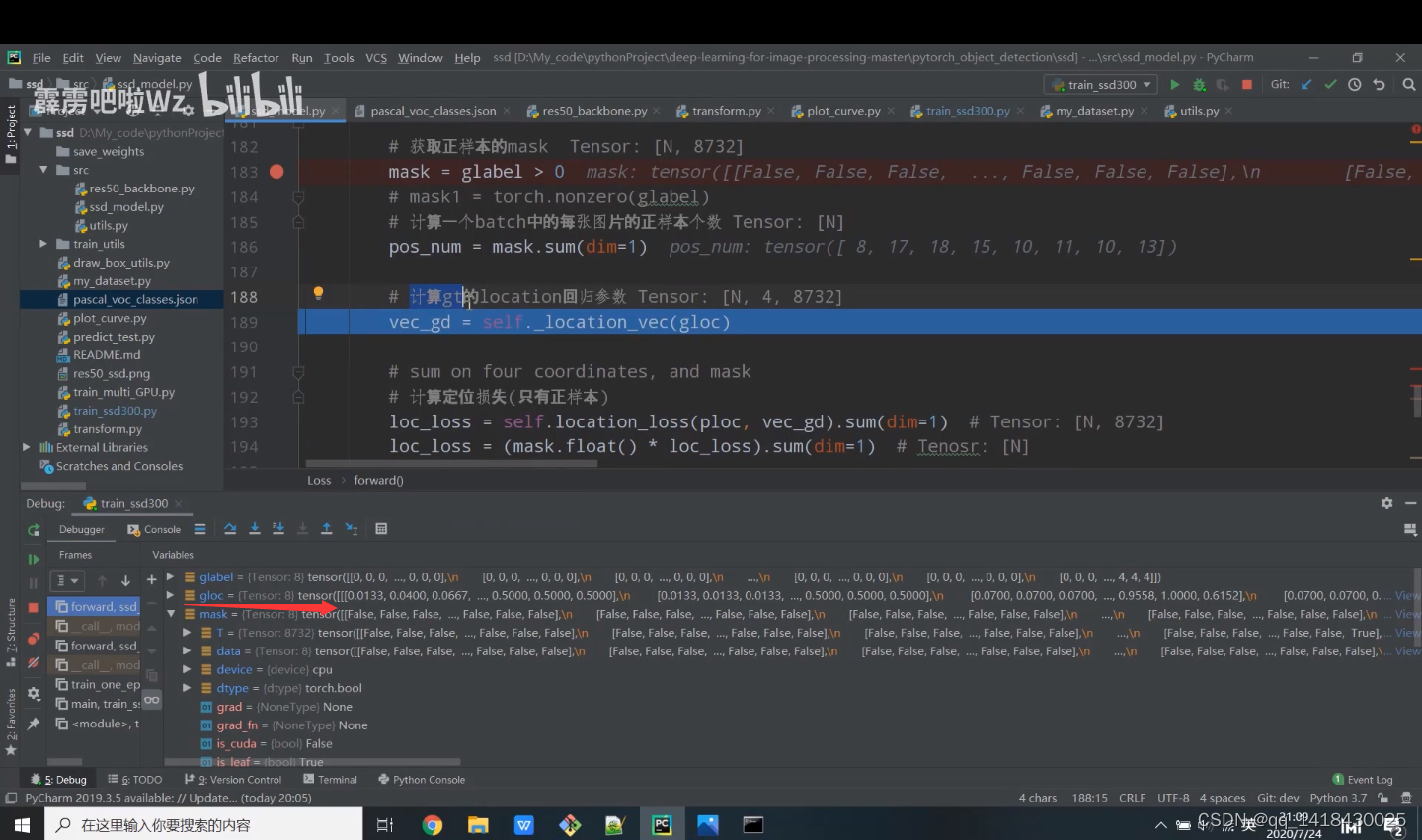
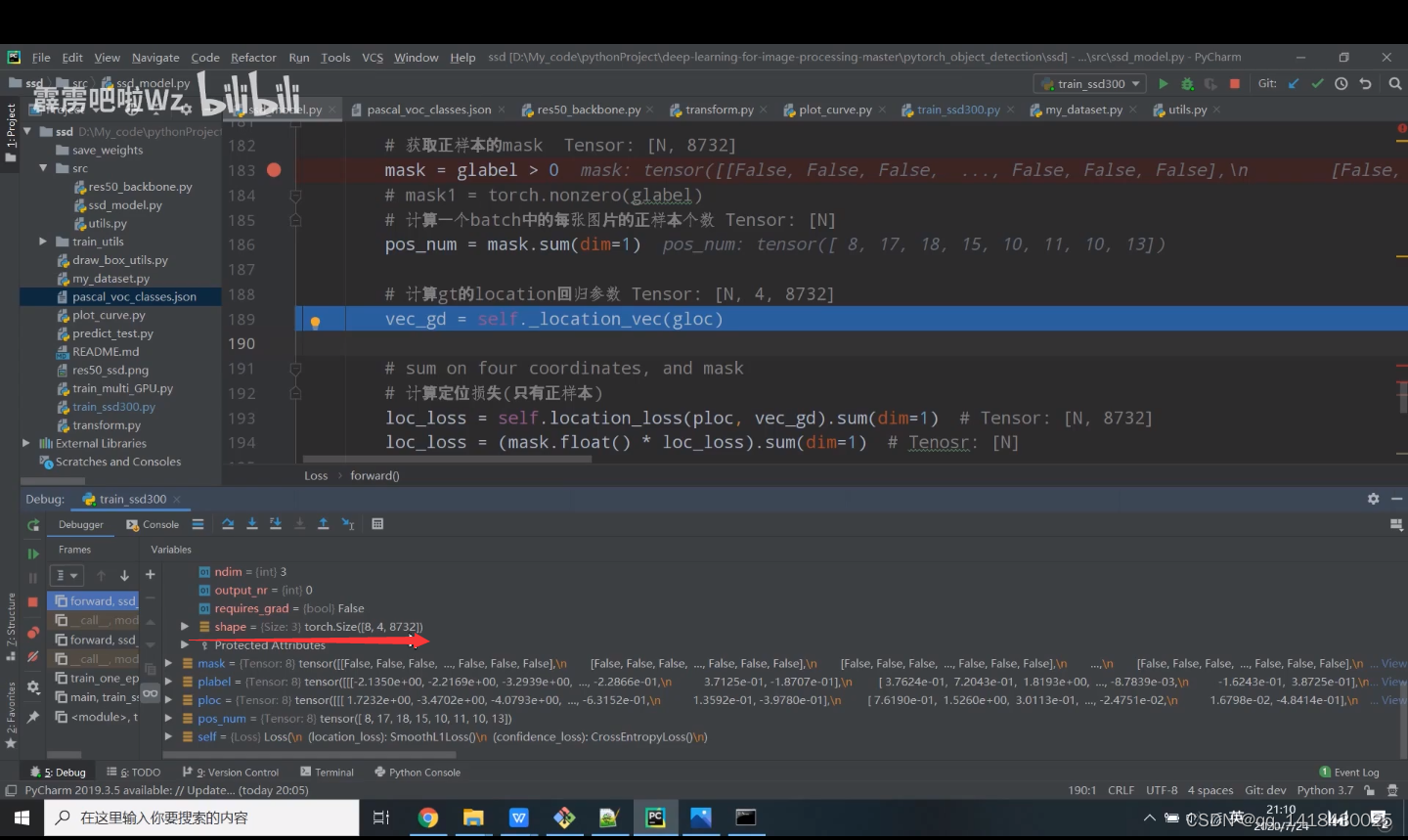
gloc参数的shape,8x4x8732(batchsize第一个),这就是为什么在loss初始化函数中将dboxes进行transpose处理第一个维度和第二个维度以及通过unsqueeze函数将第一个维度进行扩充。
4.2 定位损失的计算

关于定位损失计算:中心x和y的回归参数分别等于ground true的中心x(y)-default box(anchor)的中心x(y),再除以default box(anchor)的宽度w(高度h);宽度w和高度h分别等于ground true的宽度w(高度h)/default box(anchor)的宽度w(高度h),再取对数。
def _location_vec(self, loc):
# type: (Tensor) -> Tensor
"""
Generate Location Vectors
计算ground truth相对anchors的回归参数
:param loc: anchor匹配到的对应GTBOX Nx4x8732
:return:
"""
gxy = self.scale_xy * (loc[:, :2, :] - self.dboxes[:, :2, :]) / self.dboxes[:, 2:, :] # Nx2x8732(系数加速网络收敛)
gwh = self.scale_wh * (loc[:, 2:, :] / self.dboxes[:, 2:, :]).log() # Nx2x8732(系数加速网络收敛)
return torch.cat((gxy, gwh), dim=1).contiguous()
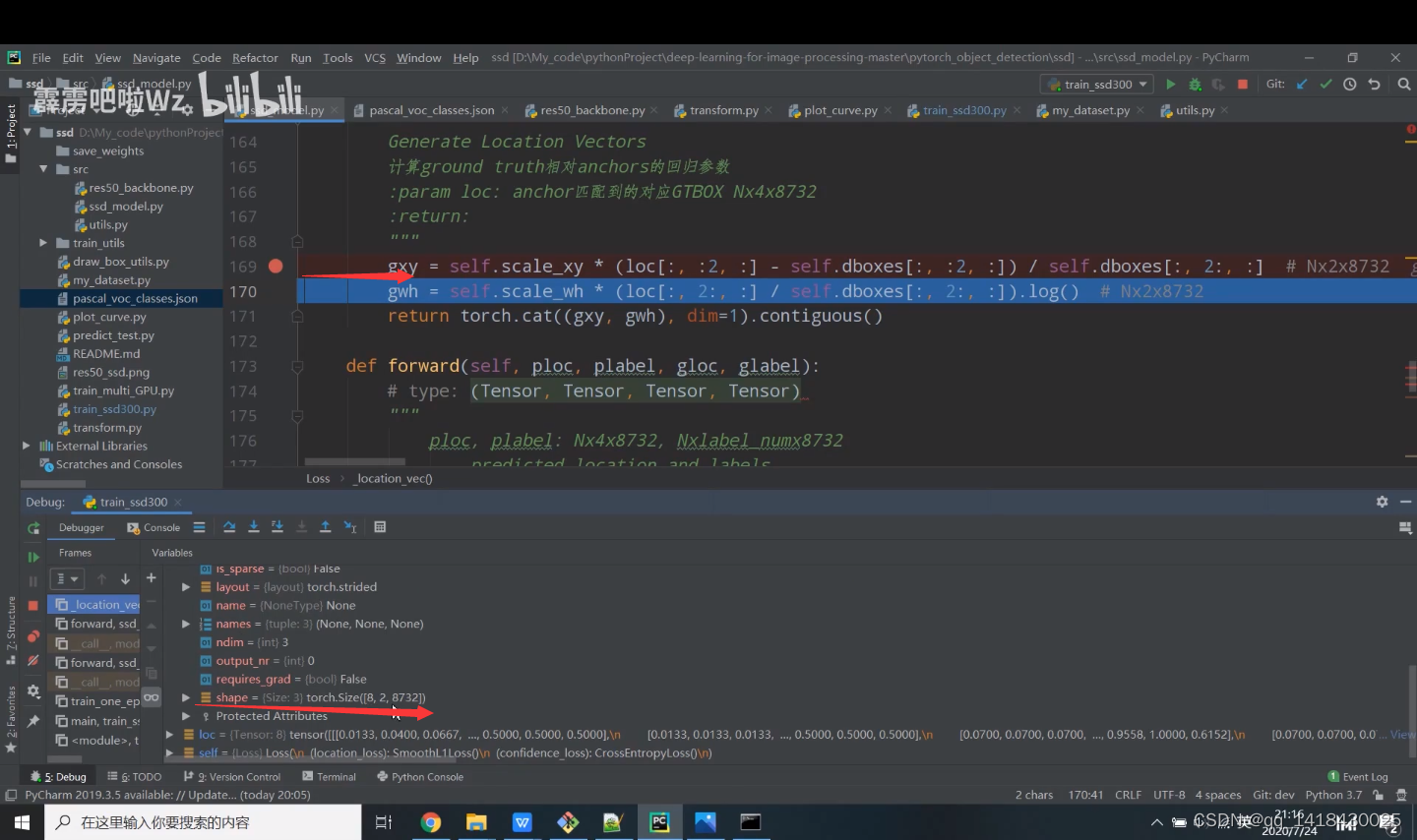
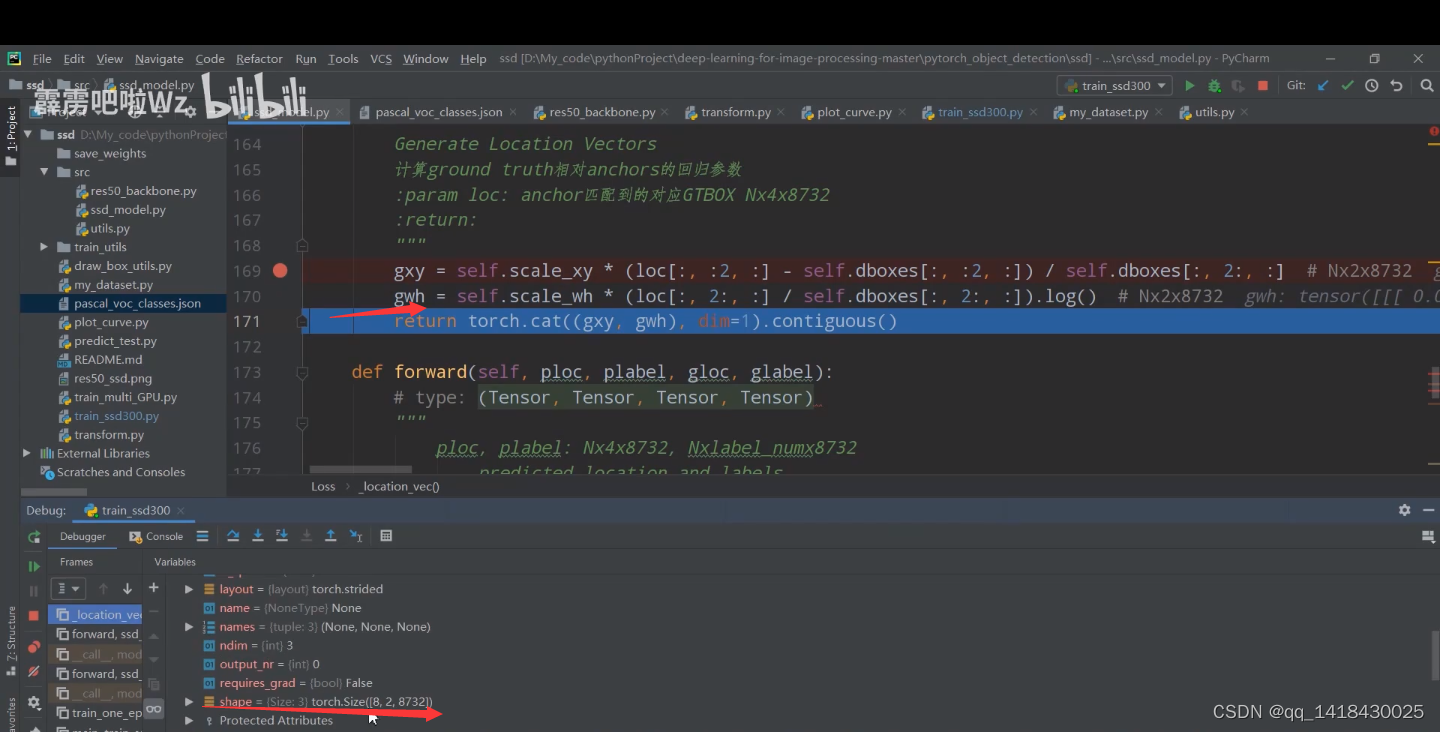
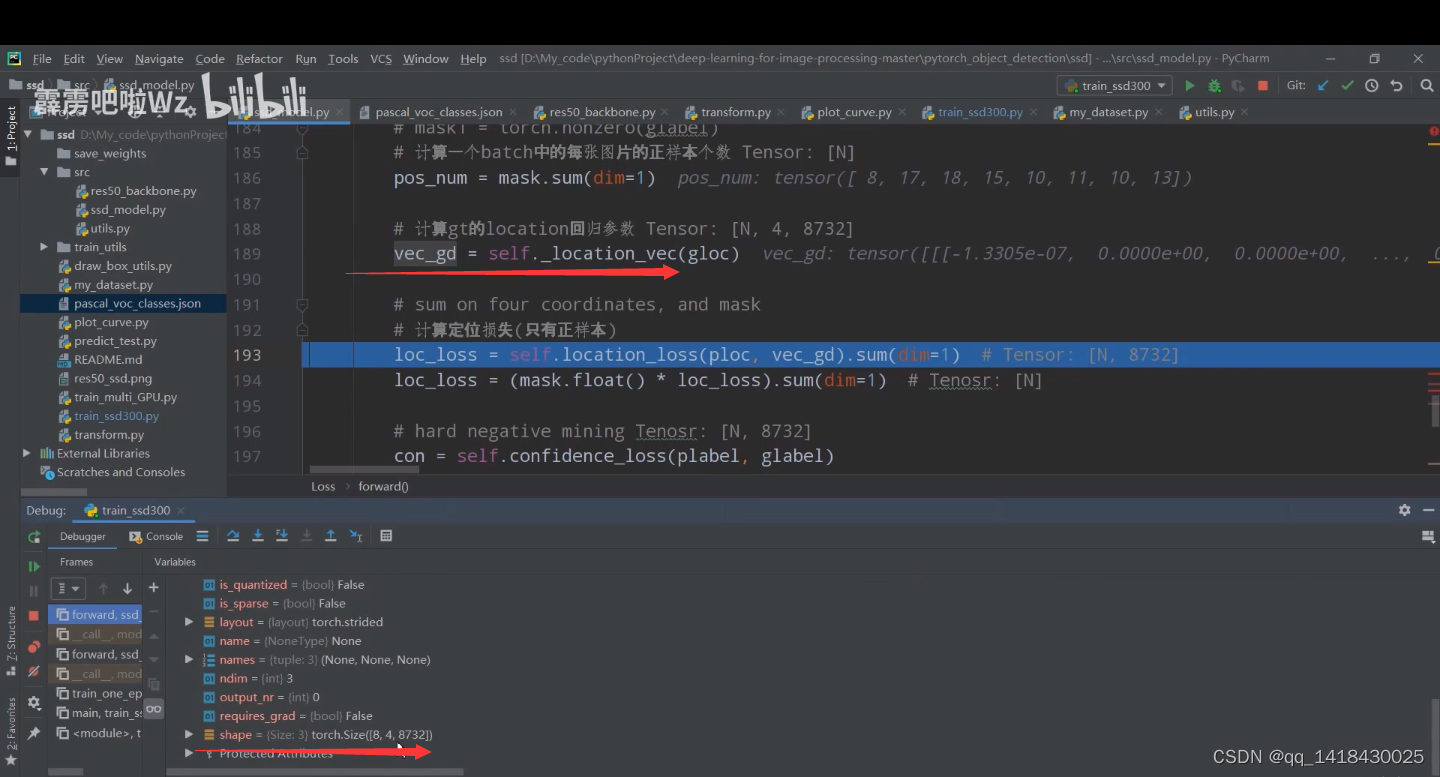
扫描二维码关注公众号,回复:
14542251 查看本文章


通过这部分得到的vec_gdshape是8x4x8732,与gloc一样。
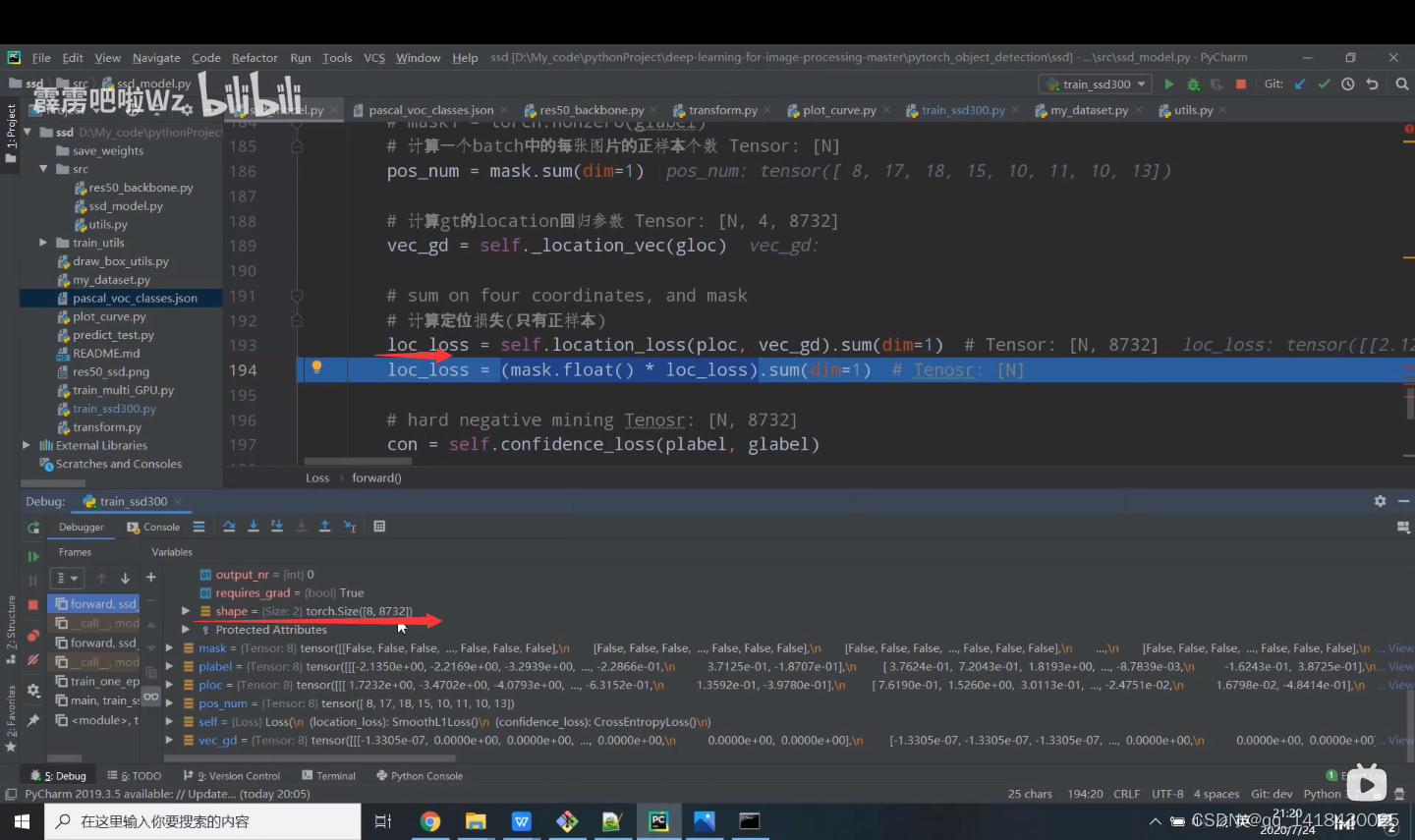
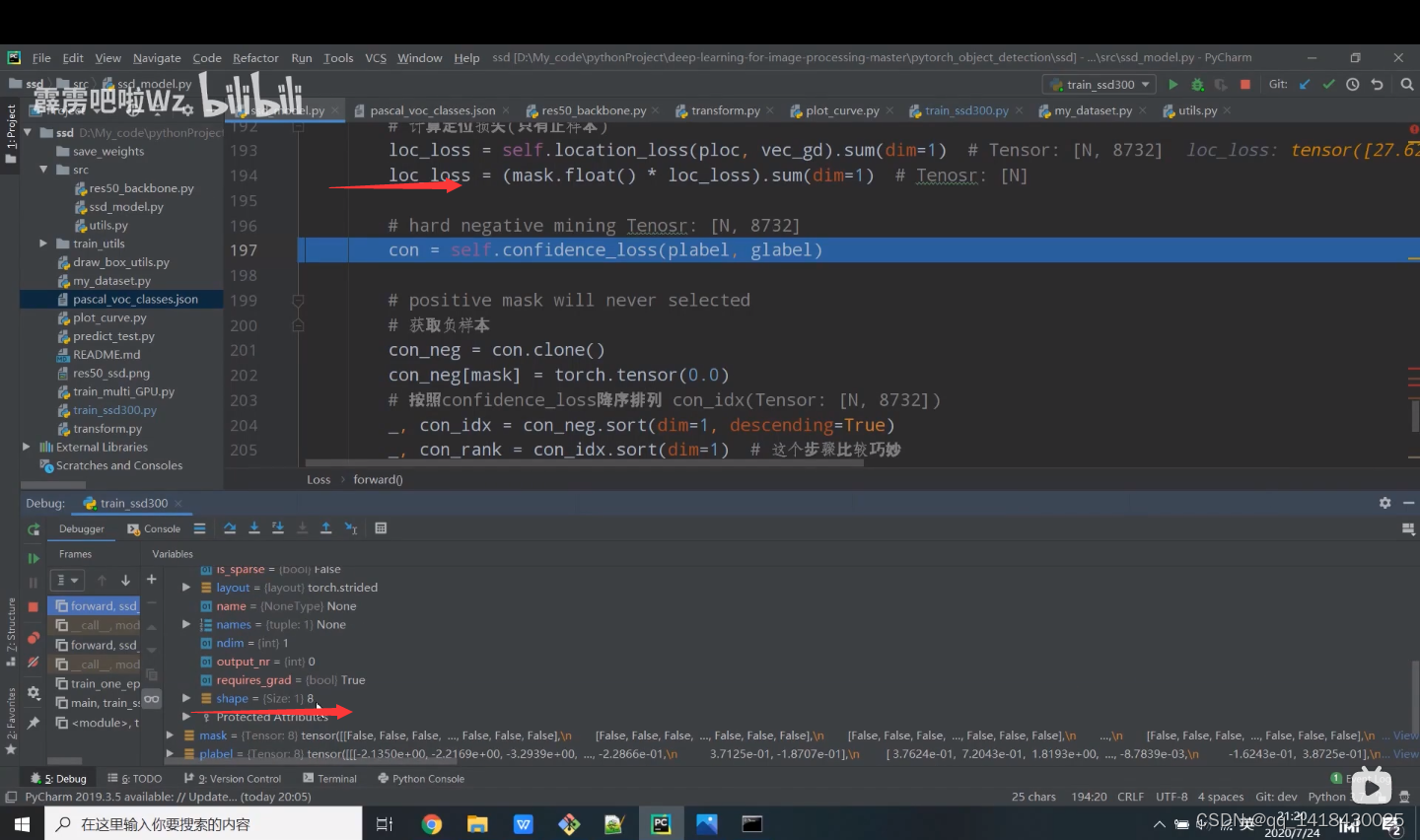
loc_loss包括正负样本损失的shape是8,8732;loc_loss只包含正样本损失的shape是8.负样本损失对于定位没有意义,所有正样本的定位损失。
4.3 负样本获取(有一个独特的排序思想)
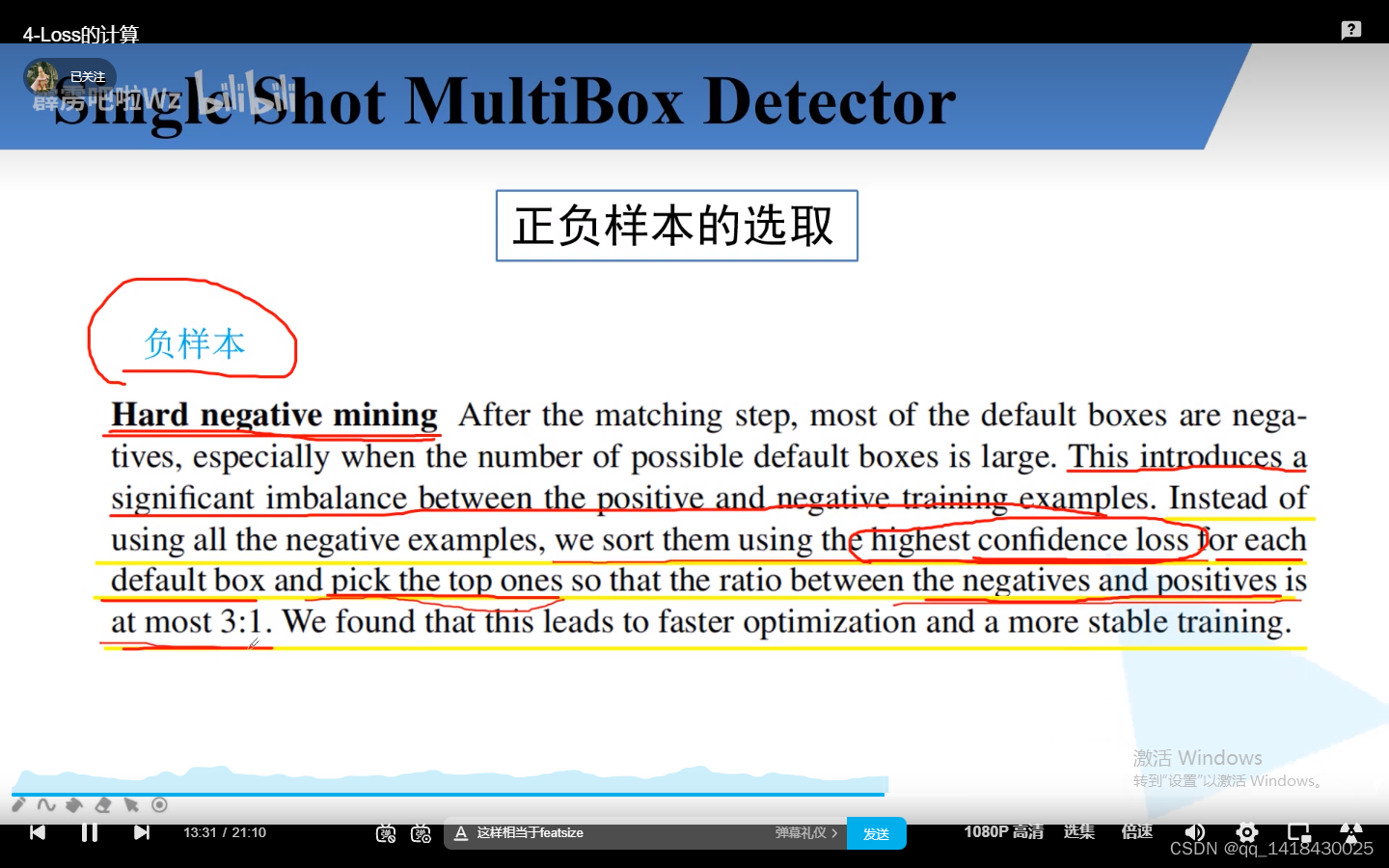
关于负样本选取,根据置信度损失分数由高到低进行排序,选取分数较高的作为负样本,正负样本的比例大概是在3:1,负样本是正样本的三倍左右.
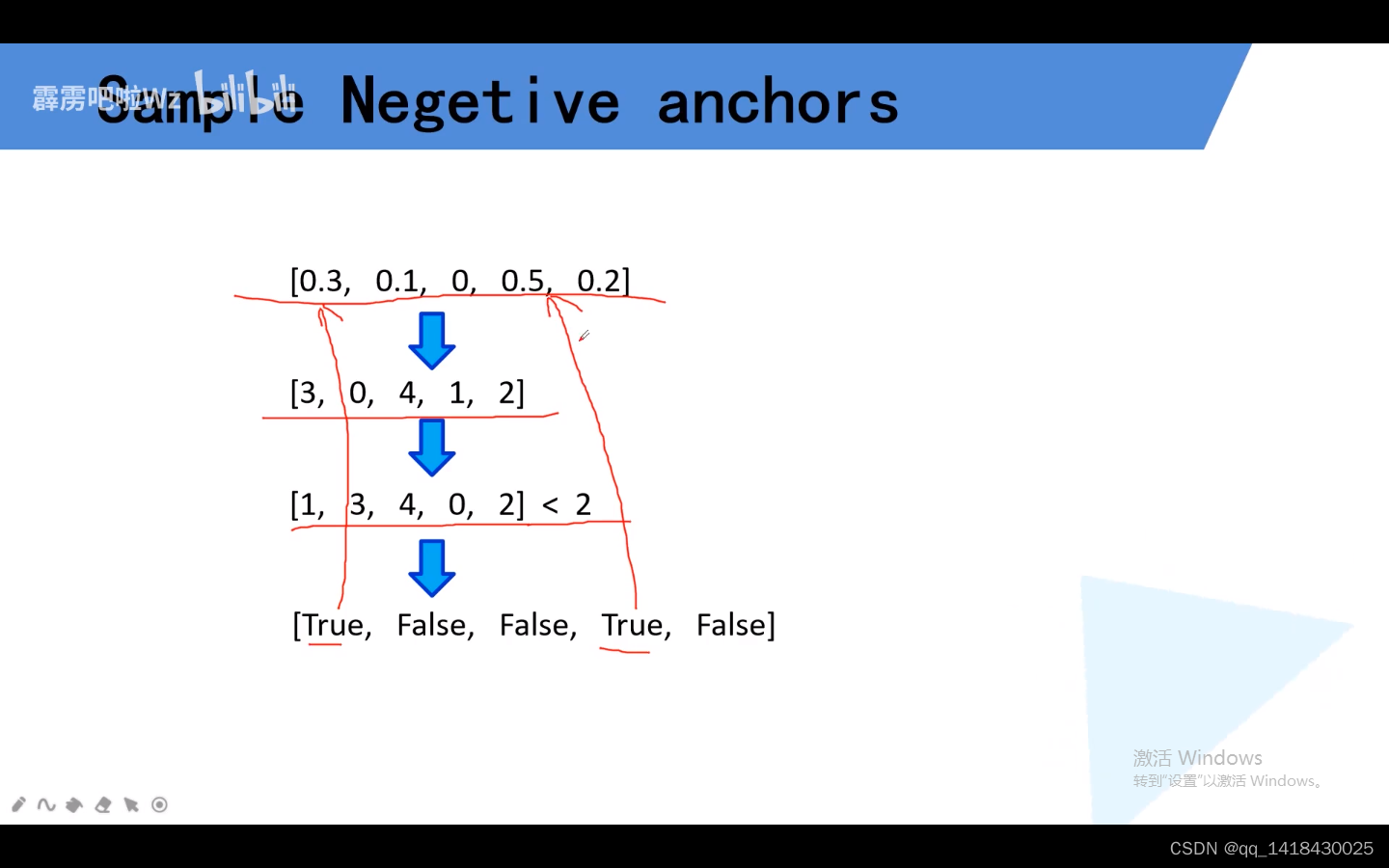
通过以上算法可以将top2的两个选取出来.
# 按照confidence_loss降序排列 con_idx(Tensor: [N, 8732])
_, con_idx = con_neg.sort(dim=1, descending=True)
_, con_rank = con_idx.sort(dim=1) # 这个步骤比较巧妙
# number of negative three times positive
# 用于损失计算的负样本数是正样本的3倍(在原论文Hard negative mining部分),
# 但不能超过总样本数8732
neg_num = torch.clamp(3 * pos_num, max=mask.size(1)).unsqueeze(-1)
neg_mask = torch.lt(con_rank, neg_num) # (lt: <) Tensor [N, 8732]
五、后处理算法
class PostProcess(nn.Module):#后处理部分
def __init__(self, dboxes):
super(PostProcess, self).__init__()
# [num_anchors, 4] -> [1, num_anchors, 4]
self.dboxes_xywh = nn.Parameter(dboxes(order='xywh').unsqueeze(dim=0),
requires_grad=False)
self.scale_xy = dboxes.scale_xy # 0.1
self.scale_wh = dboxes.scale_wh # 0.2
self.criteria = 0.5 #非极大值阈值IOU
self.max_output = 100 #输出限制 最多一百个目标
def forward(self, bboxes_in, scores_in):#坐标偏移量以及预测每一个类别
# 通过预测的boxes回归参数得到最终预测坐标, 将预测目标score通过softmax处理
bboxes, probs = self.scale_back_batch(bboxes_in, scores_in)
outputs = torch.jit.annotate(List[Tuple[Tensor, Tensor, Tensor]], [])
# 遍历一个batch中的每张image数据
# bboxes: [batch, 8732, 4]
for bbox, prob in zip(bboxes.split(1, 0), probs.split(1, 0)): # split_size, split_dim
# bbox: [1, 8732, 4] -> [8732,4]
bbox = bbox.squeeze(0)
prob = prob.squeeze(0)
outputs.append(self.decode_single_new(bbox, prob, self.criteria, self.max_output))
return outputs
def scale_back_batch(self, bboxes_in, scores_in):
# type: (Tensor, Tensor) -> Tuple[Tensor, Tensor]
"""
1)通过预测的boxes回归参数得到最终预测坐标
2)将box格式从xywh转换回ltrb
3)将预测目标score通过softmax处理
Do scale and transform from xywh to ltrb
suppose input N x 4 x num_bbox | N x label_num x num_bbox
bboxes_in: [N, 4, 8732]是网络预测的xywh回归参数
scores_in: [N, label_num, 8732]是预测的每个default box的各目标概率
"""
# Returns a view of the original tensor with its dimensions permuted.
# [batch, 4, 8732] -> [batch, 8732, 4]
bboxes_in = bboxes_in.permute(0, 2, 1)
# [batch, label_num, 8732] -> [batch, 8732, label_num]
scores_in = scores_in.permute(0, 2, 1)
# print(bboxes_in.is_contiguous())
bboxes_in[:, :, :2] = self.scale_xy * bboxes_in[:, :, :2] # 预测的x, y回归参数
bboxes_in[:, :, 2:] = self.scale_wh * bboxes_in[:, :, 2:] # 预测的w, h回归参数
# 将预测的回归参数叠加到default box上得到最终的预测边界框
bboxes_in[:, :, :2] = bboxes_in[:, :, :2] * self.dboxes_xywh[:, :, 2:] + self.dboxes_xywh[:, :, :2]
bboxes_in[:, :, 2:] = bboxes_in[:, :, 2:].exp() * self.dboxes_xywh[:, :, 2:]
# transform format to ltrb
l = bboxes_in[:, :, 0] - 0.5 * bboxes_in[:, :, 2]
t = bboxes_in[:, :, 1] - 0.5 * bboxes_in[:, :, 3]
r = bboxes_in[:, :, 0] + 0.5 * bboxes_in[:, :, 2]
b = bboxes_in[:, :, 1] + 0.5 * bboxes_in[:, :, 3]
bboxes_in[:, :, 0] = l # xmin
bboxes_in[:, :, 1] = t # ymin
bboxes_in[:, :, 2] = r # xmax
bboxes_in[:, :, 3] = b # ymax
# scores_in: [batch, 8732, label_num]
return bboxes_in, F.softmax(scores_in, dim=-1)
5.1 损失时候计算的scale_xy是10(1/0.1=10),scale_wh是5(1/0.2=5);预测的x, y回归参数是0.1和0.2.在计算gt box的回归参数时候有乘scale_xy(10)和scale_wh(5)这个缩放因子。
def decode_single_new(self, bboxes_in, scores_in, criteria, num_output):
# type: (Tensor, Tensor, float, int) -> Tuple[Tensor, Tensor, Tensor]
"""
decode:
input : bboxes_in (Tensor 8732 x 4), scores_in (Tensor 8732 x nitems)
output : bboxes_out (Tensor nboxes x 4), labels_out (Tensor nboxes)
criteria : IoU threshold of bboexes
max_output : maximum number of output bboxes
"""
device = bboxes_in.device
num_classes = scores_in.shape[-1]# +背景
# 对越界的bbox进行裁剪
bboxes_in = bboxes_in.clamp(min=0, max=1)
# [8732, 4] -> [8732, 21, 4]
bboxes_in = bboxes_in.repeat(1, num_classes).reshape(scores_in.shape[0], -1, 4)
# create labels for each prediction
labels = torch.arange(num_classes, device=device)
# [num_classes] -> [8732, num_classes]
labels = labels.view(1, -1).expand_as(scores_in)
# remove prediction with the background label
# 移除归为背景类别的概率信息 0对应背景
bboxes_in = bboxes_in[:, 1:, :] # [8732, 21, 4] -> [8732, 20, 4]
scores_in = scores_in[:, 1:] # [8732, 21] -> [8732, 20]
labels = labels[:, 1:] # [8732, 21] -> [8732, 20]
# batch everything, by making every class prediction be a separate instance
bboxes_in = bboxes_in.reshape(-1, 4) # [8732, 20, 4] -> [8732x20, 4]
scores_in = scores_in.reshape(-1) # [8732, 20] -> [8732x20]
labels = labels.reshape(-1) # [8732, 20] -> [8732x20]
# remove low scoring boxes
# 移除低概率目标,self.scores_thresh=0.05
# inds = torch.nonzero(scores_in > 0.05).squeeze(1)
inds = torch.where(torch.gt(scores_in, 0.05))[0]
bboxes_in, scores_in, labels = bboxes_in[inds, :], scores_in[inds], labels[inds]
# remove empty boxes
ws, hs = bboxes_in[:, 2] - bboxes_in[:, 0], bboxes_in[:, 3] - bboxes_in[:, 1]#右下角x-左上角x=宽度w 右下角y-左上角y=高度h
keep = (ws >= 1 / 300) & (hs >= 1 / 300)#相对值
# keep = keep.nonzero().squeeze(1)
keep = torch.where(keep)[0]
bboxes_in, scores_in, labels = bboxes_in[keep], scores_in[keep], labels[keep]
# non-maximum suppression
keep = batched_nms(bboxes_in, scores_in, labels, iou_threshold=criteria)
# keep only topk scoring predictions
keep = keep[:num_output]
bboxes_out = bboxes_in[keep, :]
scores_out = scores_in[keep]
labels_out = labels[keep]
return bboxes_out, labels_out, scores_out
5.2 官方提供的方法是在Encoder模块中有一个decode_single非极大值抑制算法,该方法效率比较低,但是便于理解,针对每一张图片的每一个类别执行非极大值抑制
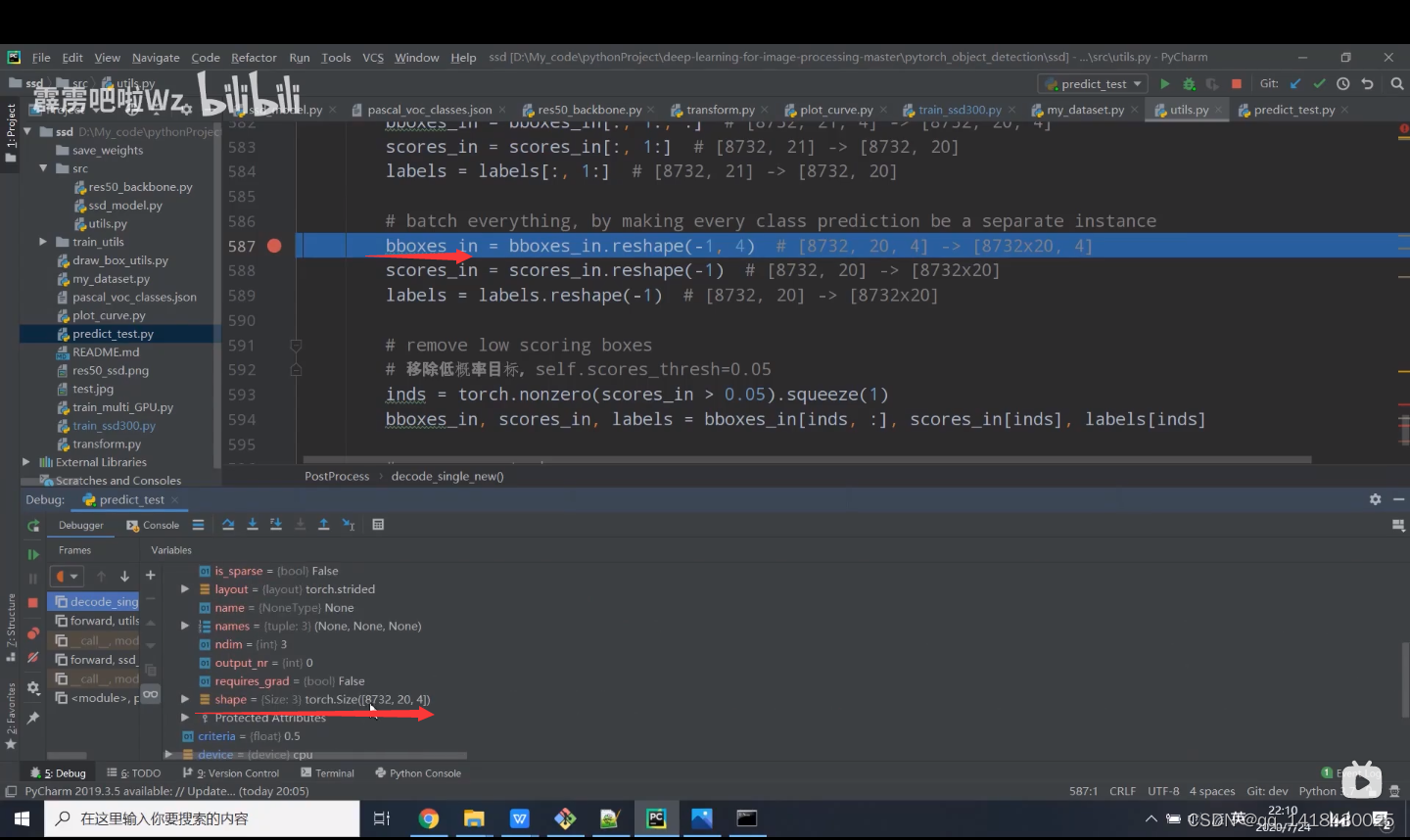
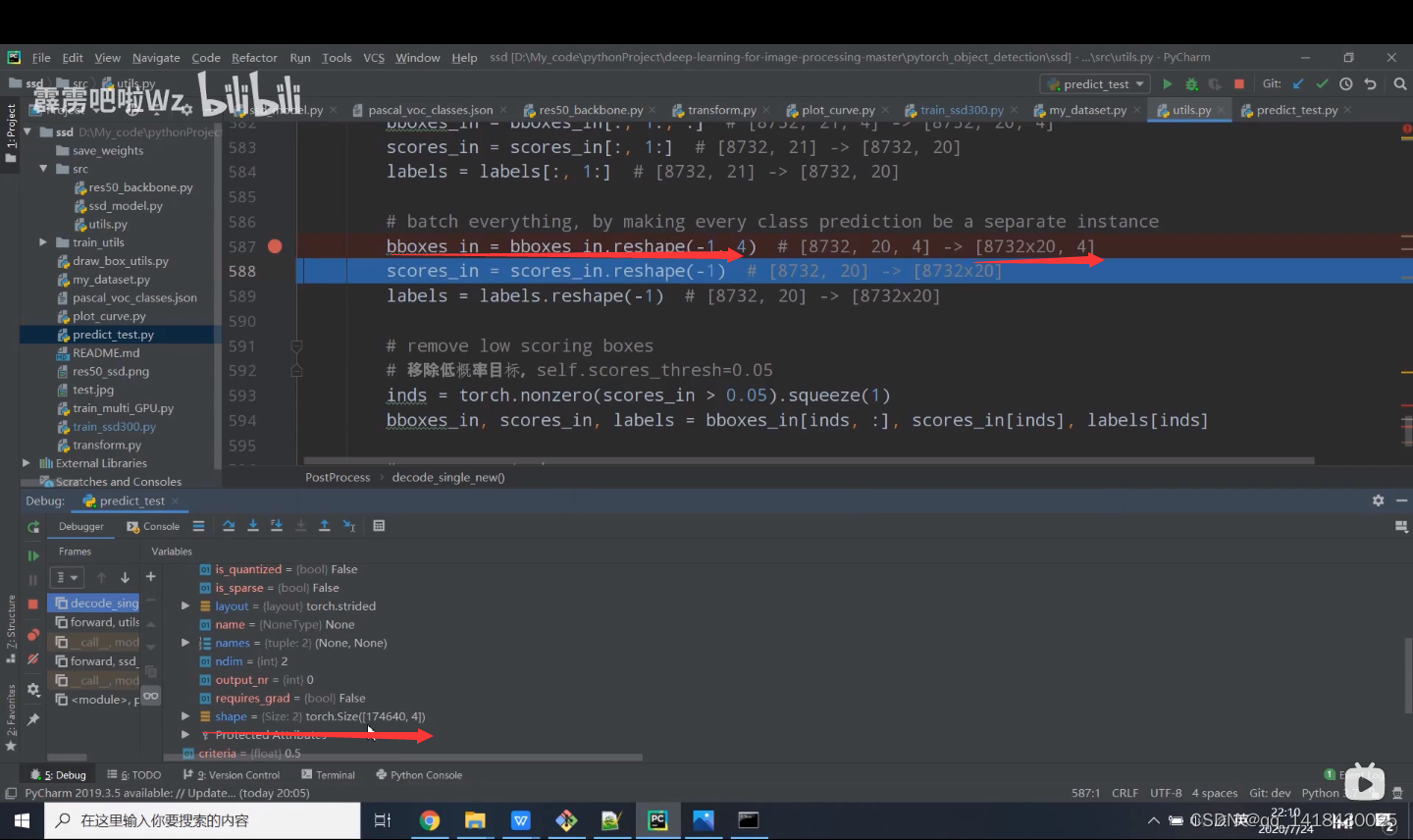
5.3 通过reshape方法可以将bboxes_in转化为展平方式,同理:scores_in,labels也是通过reshape方法转化为展平方式。下面预测原始预测没有载入预训练权重,所以预测并不准确。

def batched_nms(boxes, scores, idxs, iou_threshold):
# type: (Tensor, Tensor, Tensor, float) -> Tensor
"""
Performs non-maximum suppression in a batched fashion.
Each index value correspond to a category, and NMS
will not be applied between elements of different categories.
Parameters
----------
boxes : Tensor[N, 4]
boxes where NMS will be performed. They
are expected to be in (x1, y1, x2, y2) format
scores : Tensor[N]
scores for each one of the boxes
idxs : Tensor[N]
indices of the categories for each one of the boxes.
iou_threshold : float
discards all overlapping boxes
with IoU < iou_threshold
Returns
-------
keep : Tensor
int64 tensor with the indices of
the elements that have been kept by NMS, sorted
in decreasing order of scores
"""
if boxes.numel() == 0:
return torch.empty((0,), dtype=torch.int64, device=boxes.device)
# strategy: in order to perform NMS independently per class.
# we add an offset to all the boxes. The offset is dependent
# only on the class idx, and is large enough so that boxes
# from different classes do not overlap
# 获取所有boxes中最大的坐标值(xmin, ymin, xmax, ymax)
max_coordinate = boxes.max()
# to(): Performs Tensor dtype and/or device conversion
# 为每一个类别生成一个很大的偏移量
# 这里的to只是让生成tensor的dytpe和device与boxes保持一致
offsets = idxs.to(boxes) * (max_coordinate + 1)
# boxes加上对应层的偏移量后,保证不同类别之间boxes不会有重合的现象
boxes_for_nms = boxes + offsets[:, None]
keep = nms(boxes_for_nms, scores, iou_threshold)
return keep
5.4 NMS算法(将不同类别的边界框分开,防止重合)
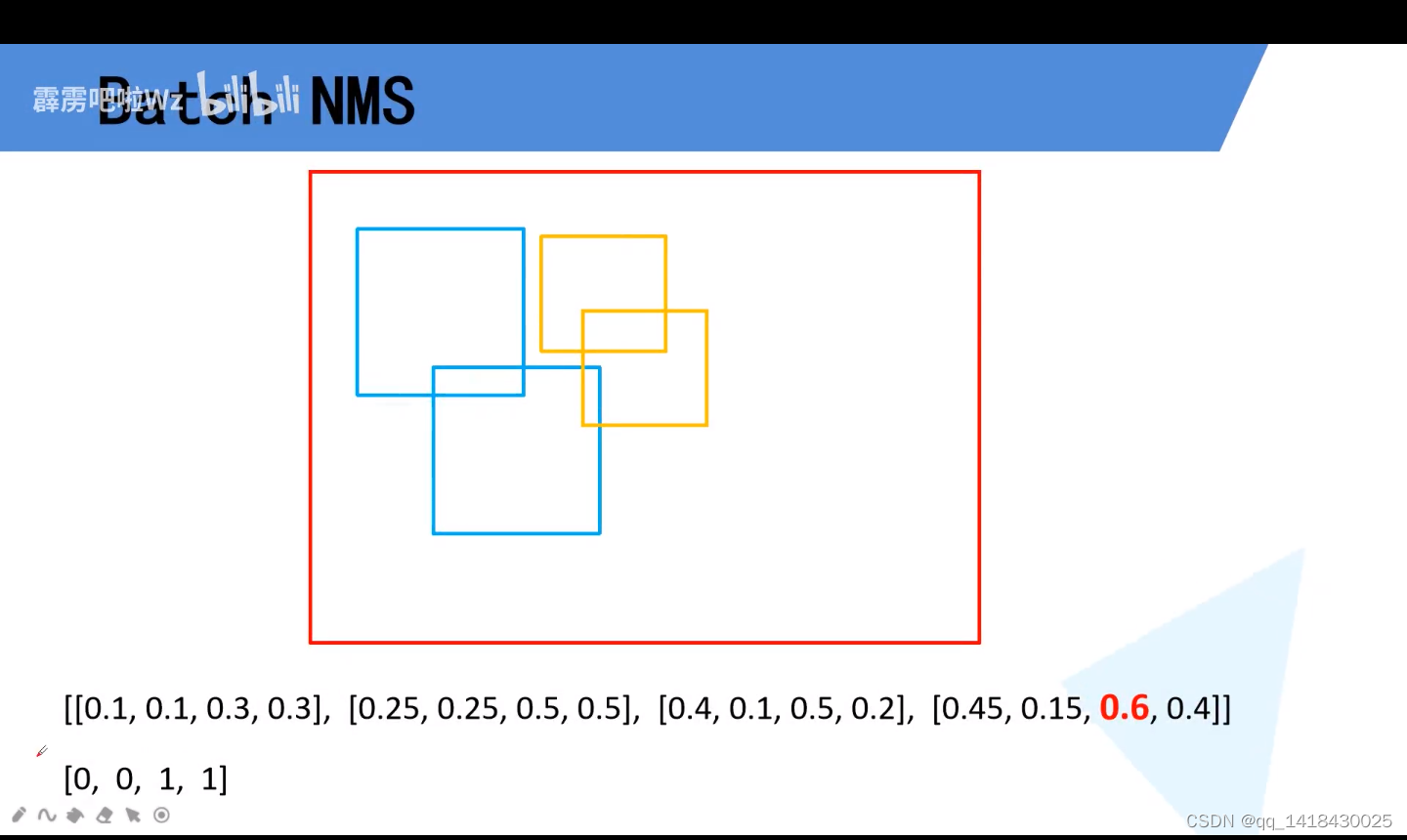

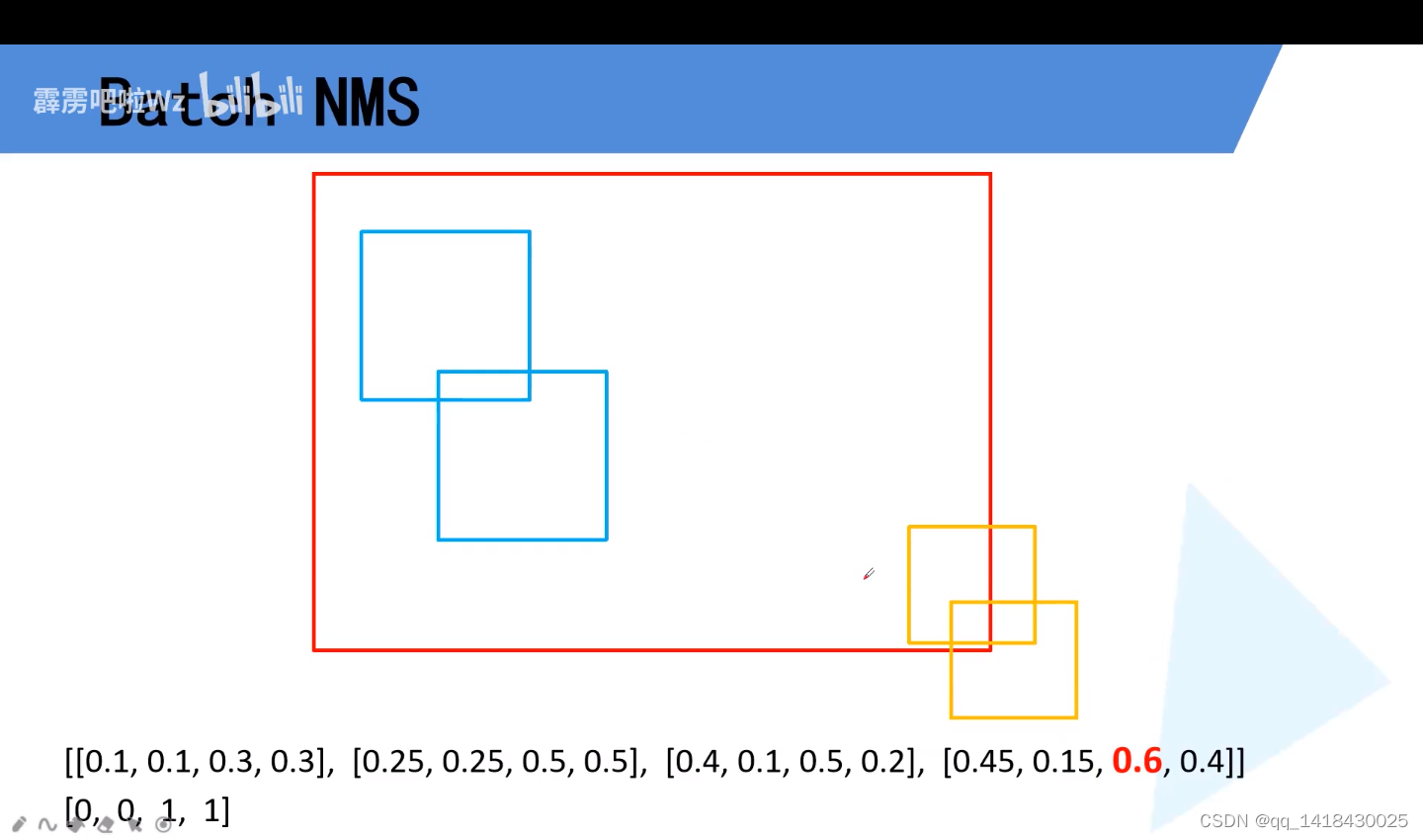
六、正负样本匹配
